

57 Best Ways to Describe Buildings in Writing (+ Examples)
One of the key components of any setting is the buildings within it.
Knowing how to describe buildings can transport your reader right into the world you’ve built.
Here’s how to describe buildings in writing:
Describe buildings in writing by utilizing architectural style, historical periods, materials used, and their cultural significance. Incorporate sensory details like soundscapes and emotional resonance. Highlight unique features, transformations, legends, and personal memories for depth.
In this article, you’ll learn all the ways to describe buildings in your writing.
1. By Historical Period

Table of Contents
Different historical periods offer a plethora of architectural designs.
When you mention a building from the Renaissance era, the image of grandeur, classic designs, and meticulous details springs to mind.
Similarly, medieval structures might invoke images of castles and fortresses.
Some historical periods to consider are:
- Ancient : Pyramids, temples, and coliseums.
- Medieval : Castles, fortresses, and walled towns.
- Renaissance : Grand manors, theaters, and palaces.
- Victorian : Ornate houses, large estates, and townhouses.
- Modern : Skyscrapers, glass-fronted buildings, and minimalist designs.
2. By Material
The building material not only imparts a physical texture to a structure but also offers a tactile feeling to your narrative.
When we describe a structure made of sandstone, readers may visualize its ruggedness and the warmth of its golden-brown hue.
On the other hand, glass skyscrapers evoke modernity and offer a reflection (both literal and metaphorical) of the urban world.
Examples of materials :
- Brick : Often seen in traditional townhouses. Think of the classic brownstones of New York.
- Marble : Conjures images of opulent palaces or Greek temples.
- Wood : Wooden lodges or cabins evoke feelings of nature, simplicity, and coziness.
- Glass : Mostly seen in modern office buildings or high-rises, suggesting transparency and sleek design.
3. By Height
Height in buildings can be an implicit indication of many things, including the period in which it was built, its function, or the aspirations of its builders.
A towering skyscraper in a business district implies a beacon of commerce and ambition.
In contrast, a quaint, single-story cottage nestled in a village street whispers tales of simplicity and tradition.
The narrative contrast is stark between the dominance of a city’s tallest structure and the humble abode that clings to the ground, embodying a quiet, unassuming charm.
Both have stories to tell, and the tales are as different as the shadows they cast.
Every building, whether ancient or modern, stands as a silent witness to the passage of time.
When describing an old, moss-covered stone building, readers might imagine the countless seasons it has withstood, the generations it has seen, and the myriad stories embedded in its walls.
A newly constructed high-rise, with its shiny facade and contemporary design, hints at a world that’s rapidly evolving, racing towards the future.
It speaks of innovation, of fresh beginnings, and sometimes, of the relentless march of progress that leaves no room for the old.
5. By Function
A building’s function is its heartbeat. It dictates the rhythm of activities inside, the kind of people who frequent it, and the emotions it evokes.
A school, for instance, might resonate with the sounds of children’s laughter, the rustling of books, and the knowledge pursuits.
Examples of functions :
- Library : A sanctuary of silence, corridors filled with the musky scent of old books, and seekers of knowledge lost in its aisles.
- Factory : Buzzing with activity, and machinery noise, indicative of industry and production.
- Barn : Evoking rustic charm, the scent of hay, and the sounds of farm animals.
- Theater : A world of art, echoing with applause, dramatic performances, and cultural expressions.
6. By Atmosphere
More than its physical attributes, the atmosphere of a building defines its soul.
It’s the difference between a church’s hallowed silence, which commands reverence, and the bustling, lively cacophony of a market square teeming with life.
While the exterior might give a hint, it’s the interior atmosphere of a building that truly draws a reader in.
The interior offers them a seat in its world, whether that’s the tranquility of a remote mountain monastery or the energetic vibe of a downtown jazz club.
7. By Surroundings
Buildings don’t exist in isolation.
They’re part of a larger tableau. Describing the surroundings sets the stage.
A lone manor at the edge of a dark forest might evoke mystery and intrigue, while the same manor overlooking a serene lake offers tranquility.
Context, in essence, is a silent storyteller.
It provides clues about the building’s purpose, its history, and its relationship with its environment.
The quaint bookshop squeezed between two modern cafes speaks of resilience amidst change.
Just as a historic monument amidst skyscrapers stands as a reminder of the city’s rich past.
8. By Color
Colors are a palette of emotions.
Describing a building’s color is akin to painting its mood.
The pastel hues of a coastal villa might convey a laid-back, beachy vibe.
Meanwhile, the monochrome shades of an urban structure suggest sobriety and functionality.
Whether it’s the radiant gold of a palace under the sun, the deep blue of a nighttime diner, or the rusty red of an old barn, colors breathe life into descriptions, making them vivid and evocative.
Size can be both a physical measure and a psychological one.
A sprawling mansion, with its many rooms and vast lawns, can indicate grandeur and opulence.
On the other hand, a small, compact house might not be grand, but it could brim with warmth and coziness.
It’s about the space, its utilization, and the feeling it imparts.
Does the vastness of a castle make one feel lost, or does it evoke a sense of awe? Does the confined space of an attic room feel claustrophobic, or does it exude intimacy?
10. By Architectural Style
Every architectural style brings with it a set of aesthetics, principles, and histories.
A Gothic cathedral, with its pointed arches and intricate detailing, is more than just a place of worship
It’s a testament to a particular period of architectural achievement.
Examples of architectural styles :
- Art Deco : Think of the glamorous 1920s, with ornate details, bold geometric forms, and lavish materials.
- Brutalist : Characterized by raw, unadorned concrete structures, it often evokes strength and functionality.
- Colonial : Reminiscent of colonization eras, with large porches, brick facades, and symmetrical designs.
- Modernist : Simplified forms, open floor plans, and a strong emphasis on horizontal and vertical lines.
11. By Cultural Influences
Every culture has its distinct architectural imprints.
Buildings influenced by a specific culture bring with them a rich tapestry of history, traditions, and artistic nuances.
For instance, a pagoda-style temple immediately brings forth Asian influences, whereas a hacienda-style house could transport readers to the heart of Mexico.
A mosque, with its minarets piercing the sky, intricately designed domes, and calligraphy-laden interiors, speaks of Islamic artistry.
A Mediterranean villa with stucco walls and red-tiled roofs tells tales of sun-kissed coasts and leisurely lifestyles.
12. By State of Repair
The condition of a building can be a rich source of narrative information.
A dilapidated mansion covered in ivy, with broken windows and creaky doors, might hint at long-forgotten stories, neglect, or even hauntings.
In contrast, a well-maintained Victorian house, freshly painted with a manicured lawn, suggests pride, history cherished and sustained.
Structures in ruins, especially historic ones, often feel melancholic, reminding readers of the inexorable march of time.
Meanwhile, buildings under construction are beacons of progress, symbolizing hope, aspirations, and the future.
13. By Decorative Elements
Details matter.
An ornate balcony with wrought-iron railings, statues adorning entrances, or stained glass windows can offer readers visual treats and clues about a building’s history and the aesthetic preferences of its inhabitants or architects.
Examples of decorative elements :
- Gargoyles : Often found in Gothic structures, these stone creatures serve both decorative and architectural purposes.
- Frescoes : Painted walls or ceilings, common in Renaissance buildings, depict scenes or stories.
- Mosaics : Pieces of colored glass or stones arranged to form patterns or images, frequently found in Byzantine architecture.
- Columns : Pillars that might be Doric, Ionic, or Corinthian, each bringing a different historical and aesthetic layer.
14. By Lighting
Light, both natural and artificial, plays a significant role in setting the mood.
A cathedral bathed in the soft hues of sunlight filtering through stained glass windows offers a kaleidoscope of colors and emotions.
Conversely, an alleyway dimly lit by a lone lamp post might evoke feelings of solitude or mystery.
The glow of lanterns in an old inn or the harsh neon lights of a modern nightclub can drastically alter the way a building is perceived, grounding readers in a specific time or mood.
15. By Acoustics
Beyond the visual, what does a building sound like?
The echo of footsteps in a grand marble hall, the muffled sounds in a carpeted library, or the lively acoustics of a music hall can immerse readers deeper into the setting.
Acoustics can also serve as indicators.
Sound bouncing off the walls of an empty mansion might evoke feelings of loneliness or abandonment.
Buildings like opera houses or concert halls, specially designed for optimal acoustics, not only emphasize the significance of sound but also bear testimony to the architectural marvels dedicated to the art of sound.
16. By User Experience
How does one navigate or experience the building?
A labyrinthine palace with endless corridors and secret chambers can give a sense of mystery.
In contrast, an open-plan modern office emphasizes transparency and collaboration.
The ease or difficulty of navigating a space, the viewpoints offered by balconies or windows, and even the experience of ascending a grand staircase versus taking a modern elevator can offer readers insights into the building’s purpose and the era’s design principles.
17. By Integration with Nature
Some buildings seamlessly integrate with their natural surroundings, while others stand out.
A cottage with walls covered in ivy, almost hidden by the woods around it, offers a different narrative than a steel-and-glass structure stark against a forest backdrop.
Consider a treehouse that becomes one with the canopy or a desert abode designed for optimal cooling.
Either way, the relationship between a building and its environment can be a rich descriptor, highlighting harmony or discord.
18. By Innovations or Anachronisms
Certain structures stand out due to their innovative designs or features that are anachronistic for their time.
An ancient building with ahead-of-its-time water systems, or a futuristic house with solar integrations and smart tech in a traditional neighborhood, can be points of interest.
Such descriptions can surprise the reader, make them curious, or emphasize the uniqueness and significance of a structure.
19. By Symbolic Significance
Beyond their tangible attributes, some buildings hold symbolic meanings.
They might represent power (like a king’s palace), spirituality (like a temple or church), knowledge (like a grand library), or even decay and decline (like ruins).
The symbolic weight of a building can add depth to its description and make it more resonant in the narrative.
20. By Popularity or Notoriety
Lastly, how is the building perceived by the masses?
Is it a famous landmark, a tourist magnet with crowds always milling about?
Or perhaps it’s a notorious structure, shunned by locals due to dark tales or unfortunate histories.
The public’s perception of a building, whether a beloved local bakery or a haunted mansion, can influence its role in the story and shape the readers’ attitudes towards it.
21. By Ornamentation and Artistry
Buildings can be embellished with diverse forms of ornamentation, from intricate carvings to frescoes.
This decor often reflects the cultural and historical contexts, as well as the individual tastes of its creators.
A building adorned with gargoyles and flying buttresses, for example, might point towards Gothic influences.
- Baroque Churches : Filled with lavish ornamentation, gilded statues, and dramatic frescoes.
- Indian Temples : Carved with intricate sculptures depicting gods, goddesses, and tales from epics.
- Art Nouveau Buildings : Characterized by sinuous lines, floral motifs, and harmonious curves.
22. By Patronage or Ownership
The patron or owner of a building can provide essential insights into its style, purpose, and decor.
Palaces built by powerful rulers often reflect their ambitions, tastes, or the political needs of their time.
On the other hand, structures erected by philanthropists might emphasize utility and public welfare.
- The Medici family in Renaissance Florence sponsored numerous buildings that became masterpieces of their era.
- The Rockefeller Center in New York, financed by the Rockefeller family, is a beacon of art deco design and urban planning.
23. By Architectural Movement
Every era spawns architectural movements with distinct principles and aesthetics.
Describing a building by its movement aligns it with specific philosophies, materials, and designs.
The minimalist, functional approach of the Bauhaus contrasts with the ornate designs of the Rococo.
- Bauhaus : Emphasizes functionality and eschews unnecessary ornamentation.
- Rococo : Known for its playful, whimsical, and intricate designs, often in pastel colors.
24. By Social and Economic Status
Buildings can often depict the socio-economic status of their inhabitants or the region they’re located in.
Mansions, penthouses, and gated communities often exude opulence.
In comparison, slums, tenements, and worker cottages might highlight poverty or the working-class struggles.
Examples: The elegant townhouses of London’s Belgravia versus the narrow, crowded lanes of Dharavi in Mumbai.
25. By Sensory Appeal
Beyond sight, buildings can be described by how they appeal to other senses.
The scent of aged wood in a historic home, the touch of cool marble underfoot in a palace, or the distant sounds echoing through a vast cathedral can make descriptions more immersive.
- The warm, inviting scent of freshly baked bread from a French bakery.
- The gentle, rhythmic tapping of rain on a tin-roofed cottage.
26. By Folklore or Legend
Some buildings are shrouded in myths, legends, or local tales.
A castle might be infamous for its ghostly residents, or a historic home might be revered as a hero’s birthplace.
Such tales add depth, intrigue, and cultural context.
- The legend of the Tower of London’s ravens, suggesting the kingdom’s fall if they ever leave.
- The lore surrounding Transylvania’s Bran Castle, often linked with the Dracula legend.
27. By Climate Adaptation
Buildings can be designed or modified to adapt to their climatic conditions.
A desert home might have thick walls to keep the interiors cool, while houses in tropical regions might feature wide verandas and high ceilings for ventilation.
- The igloos of the Arctic, built from blocks of snow.
- Traditional Arabian homes with wind towers for natural cooling.
28. By Relation to Other Structures
The juxtaposition of a building with its neighboring structures can offer rich contrasts or harmonies.
A medieval church beside a modern mall might highlight the city’s layered history or the interplay of the sacred and the commercial.
- The Flatiron Building in New York, with its unique triangular shape, set against the backdrop of modern skyscrapers.
- Rome’s Pantheon, an ancient temple, surrounded by renaissance buildings and modern cafes.
29. By Adaptive Reuse
Old structures might be repurposed for new functions, preserving their history while adapting to contemporary needs.
Warehouses transformed into lofts, churches turned into bookshops, or palaces renovated into hotels.
Transformations show the evolving narratives of buildings.
- The Tate Modern in London, once a power station.
- Book and Bed Hostels in Tokyo, combining bookshops with sleeping quarters.
30. By Emotional Resonance
How does a building make one feel?
Describing the emotional response it evokes can be more powerful than detailing its physical attributes.
A derelict asylum might exude eeriness, while a childhood home could evoke nostalgia.
- The somber, reflective atmosphere of the 9/11 Memorial.
- The joy and wonder of entering the whimsical world of Gaudí’s Casa Batlló in Barcelona.
31. By Historical Events
Many buildings carry the weight of significant historical events.
These events can cast a long shadow over the building’s atmosphere and its place in society.
For instance, a palace that was the site of a famous treaty signing or an assassination takes on the weight and significance of those events, shaping how one views and describes it.
The mere mention of such a building might evoke a vivid picture in the reader’s mind, filled with the drama and emotion of the past.
- The Palace of Versailles in France, which witnessed numerous royal dramas and the signing of the Treaty of Versailles.
- Ford’s Theatre in Washington D.C., forever remembered as the assassination site of President Abraham Lincoln.
32. By Foundation
The foundation of a building is its bedrock, dictating its stability, longevity, and sometimes even its aesthetic appeal.
It speaks volumes about the building’s resilience, design intentions, and the environment it’s in.
Different terrains require different types of foundations.
A building’s foundation can indicate whether it’s designed to withstand earthquakes, floods, or other environmental factors.
- Stilt homes in flood-prone areas, raised above ground level, showcase the adaptation to the local environment.
- Buildings in earthquake-prone regions like Japan might have deep foundations and reinforced pillars to absorb shocks.
33. By Roof
Roofs provide shelter but also contribute to a building’s identity.
They often serve as an architectural highlight or adaptation to the climate of a region.
A roof can be symbolic of a region’s architectural history or a practical response to weather conditions. It can be decorative or functional, or both.
- The distinct pagoda-style roofs in ancient Chinese architecture, with their upturned eaves.
- Thatched roofs of English cottages, providing insulation and showcasing a rustic charm.
34. By Landscape Integration
How a building integrates or stands out from its surrounding landscape can be a focal point of description.
A mansion atop a hill overlooking a town tells a story of dominance or isolation, while a camouflaged cabin in the woods speaks of retreat and harmony with nature.
- Machu Picchu in Peru, a stone city seamlessly integrated into the mountainous terrain.
- Cliffside dwellings like the Hanging Temple in China, defying gravity and blending with the vertical landscape.
35. By Socio-political Context
Architecture often mirrors the socio-political climate of its time.
Structures built during totalitarian regimes might exude power and intimidation, while those from a renaissance period might reflect hope, curiosity, and the human spirit.
Describing buildings within this context can enhance the depth of a story, setting the stage for the characters’ challenges and triumphs.
- The grandeur of Stalinist architecture, like the Seven Sisters in Moscow, representing power and state dominance.
- The democratic openness of city halls and public squares in many European cities, symbolizing public participation and freedom.
36. By Architectural Philosophy
Some buildings are constructed based on specific architectural philosophies or principles.
Perhaps the Japanese philosophy of “Wabi-sabi” celebrating imperfection or the Modernist mantra “form follows function.”
These guiding principles can be a unique way to delve into the building’s essence.
- Fallingwater by Frank Lloyd Wright, embodying the philosophy of organic architecture.
- The grid-like simplicity of De Stijl architecture , as seen in Rietveld Schröder House.
37. By Spiritual or Religious Significance
Many structures are steeped in spiritual or religious significance, making them more than just brick and mortar.
Temples, churches, mosques, and other religious edifices often come loaded with symbolic elements, rituals, and an aura of reverence.
- The Notre-Dame Cathedral i n Paris, with its Gothic spires, rose windows, and religious relics.
- The intricately carved Jain temples of India, representing non-violence and respect for all living beings.
38. By Reflection of the Times
Architecture can be a mirror to the prevalent trends, technology, and societal values of its era.
A post-war building might carry elements of resilience and simplicity.
Structures from a prosperous era might, instead, exude opulence and flamboyance.
- Art Deco buildings of the Roaring Twenties, like the Chrysler Building in New York, symbolizing prosperity and technological progress.
- The austere, functional buildings of post-World War II Europe, reflecting the continent’s recovery phase.
39. By Personal Stories and Anecdotes
Every building might have personal stories or anecdotes linked to it.
These tales, whether of love, tragedy, triumph, or everyday life, can turn a mundane structure into something special.
A house might be remembered for the family feuds it witnessed, or a bridge might be iconic for a legendary love story.
- The Romeo and Juliet balcony in Verona, believed to be the site of the famous Shakespearean love story.
- The childhood homes of famous personalities, like Mozart’s Geburtshaus in Salzburg, which tells tales of prodigious talent and early beginnings.
40. By Flooring
Flooring can reflect the luxury, practicality, or cultural elements of a building.
It plays a significant role in interior aesthetics and user comfort.
The choice of flooring material, its texture, and design can say a lot about the purpose of a room and the building’s overall theme.
- Design: The intricately designed marble floors of palaces, indicating opulence and grandeur.
- Material: Bamboo or tatami mat flooring in traditional Japanese homes, bringing forth an essence of simplicity and nature.
41. By Urban vs. Rural Setting
The setting of a building, whether in a bustling urban environment or a serene rural backdrop, affects its architecture, materials used, and its overall ambiance.
Urban structures might prioritize vertical expansion and efficient space use.
Rural ones might spread outwards, integrating with nature.
- The compact, upward-stretching skyscrapers of Manhattan versus the sprawling ranches of Montana.
- Ancient European farmhouses nestled in valleys versus modern urban apartments with their balconies facing busy streets.
42. By Ecological Impact
With the rising emphasis on sustainability, many buildings are now designed with their ecological footprint in mind.
Consider green roofs and walls to structures entirely powered by renewable energy.
There’s a growing trend towards eco-friendly architecture.
- The Bullitt Center in Seattle is called the world’s most eco-friendly office building.
- Ancient cliff dwellings, which utilized natural rock formations to maintain interior temperatures and minimize impact on the environment.
43. By Underground Space
A building’s underground space can reveal hidden functions, histories, or layers of utility that aren’t immediately visible on the surface.
Basements, cellars, underground bunkers, or parking spaces can add layers of mystery, function, or historical depth.
- Ancient catacombs or crypts beneath churches, like the Catacombs of Paris, harboring history and tales of the departed.
- Modern skyscrapers with multiple levels of underground parking and utility spaces, showcasing urban space optimization.
44. By Human Interaction
How people interact with a building can be a powerful descriptor.
Are its halls always crowded?
Do children play in its courtyards? Is it a place of solitude or social interaction?
Such descriptions bring the building to life, emphasizing its role in the community.
- The lively bustle of Grand Central Terminal in New York, with commuters rushing, tourists marveling, and couples reuniting.
- The tranquil corridors of monasteries, where the only sounds might be the soft footsteps of monks.
45. By Technological Advancements
In the modern age, buildings can be described by the technology they incorporate.
Smart homes, buildings with integrated AI systems, or structures with advanced security systems reflect the advancements of the age.
- The Edge in Amsterdam, touted as the world’s smartest building, where even the coffee machines are connected to the internet.
- Historical aqueducts and water systems, showcasing the engineering prowess of ancient civilizations.
46. By Adaptability and Flexibility
Some buildings are designed to be adaptable to different needs over time.
These structures might have movable walls, transformable spaces, or modular designs that can evolve with changing requirements.
- The Habitat 67 complex in Montreal, where prefabricated modules can be reconfigured.
- Japanese homes designed with large open spaces that can serve multiple purposes, from living rooms in the day to sleeping areas at night.
47. By Fragrance and Aroma
Though subtle, the distinctive smells associated with certain buildings can paint a vivid picture.
A library’s musty scent, the fresh aroma from a bakery, or the mix of incense in a temple can transport the reader to the location instantly.
- The cedarwood fragrance permeating ancient temples in Kyoto.
- The unmistakable scent of chlorine in indoor swimming complexes.
48. By Security Features
Security features can provide insights into the importance, vulnerability, or the treasures a building holds.
It can also reflect the socio-political environment of the locale.
A building heavily fortified indicates its importance or the potential threats it might face, whereas minimal security might indicate peace, openness, or a lack of valuable contents.
- The Buckingham Palace with its guards, high walls, and surveillance systems, highlighting the importance and the need to protect the monarchy.
- A quiet, open-plan library in a small town, with just CCTV cameras, showcases the trust in the community and the open access to knowledge.
49. By Mystique and Legends
Every region has its tales, its myths, and sometimes these stories are intrinsically tied to certain structures.
A haunted house, a castle rumored to have hidden treasures, or an inn with tales of historical figures stopping by can add a layer of mystique and depth to the description.
- The Tower of London, with its many ghostly tales including that of Anne Boleyn.
- Château de Brissac in France, also known as the “Giant of the Loire Valley,” renowned for its ghost, “la Dame Verte” or the Green Lady.
50. By Seasons and Weather
The way a building interacts with different seasons can be enchanting.
How it stands resilient during winter storms, becomes enlivened by spring blossoms, offers shade in summer, or is framed by autumn leaves can bring a dynamic quality to descriptions.
- Neuschwanstein Castle in Germany, often pictured blanketed in winter snow, looking like a fairy-tale come alive.
- Traditional Japanese homes with engawas (verandas) designed to appreciate seasonal changes, especially the sakura bloom in spring.
51. By Movement and Dynamics
While buildings are inherently static, the environment around them isn’t.
Describe how shadows move across a structure during the day, how it appears through the mist, or how its reflection dances on water.
These details can capture a building’s dynamic interplay with the environment.
- The play of sunset hues on Petra’s Al-Khazneh in Jordan, making the ancient rose-red city look aflame.
- The Marina Bay Sands hotel in Singapore, with its surrealistic appearance as it reflects on the bay waters.
52. By Proportions and Geometry
A building’s proportions, symmetry, or lack thereof, and its geometrical design elements can serve as potent descriptors.
They can convey balance, chaos, grandeur, or coziness, depending on the design.
- The perfectly symmetrical facade of the Taj Mahal in India, representing balance and beauty.
- The twisted and unconventional design of the Dancing House in Prague, which challenges traditional architectural norms.
53. By Hidden or Secret Elements
Every building might have its hidden nooks, secret passages, or lesser-known elements.
Describing these can add an element of intrigue and adventure to the narrative.
- The hidden chambers and passageways of Hampton Court Palace in England.
- The concealed courtyards of Marrakech’s riads, which offer an oasis of calm in the midst of the city’s hustle.
54. By Time of Day
The time of day can drastically change how a building is perceived.
Dawn might cast a soft golden glow, midday could highlight the structure’s magnificence under bright light.
Dusk might lend a serene hue, while nighttime could unveil a structure illuminated in artificial lights.
- Eiffel Tower in Paris, which transforms from an iron lattice structure in the day to a sparkling jewel at night.
- Ancient ruins like Stonehenge, which take on a mystical aura during the solstice sunrise.
55. By Parking
Parking can offer a unique perspective on the accessibility, modernity, and practical aspects of a building.
A skyscraper might have a multi-level underground parking facility, while a countryside inn might just have a gravel lot.
The type and style of parking can shed light on the type of people frequenting the building and its location.
Parking is a functional aspect that often gets overlooked.
Yet, it can provide insights into the modern infrastructure and the building’s capacity to accommodate visitors.
- The Burj Khalifa in Dubai, known for its expansive parking decks, indicative of the structure’s modernity and the bustling crowd it attracts.
- A centuries-old church in a European town, with only a cobblestone path leading up to it and no dedicated parking, emphasizing its age and the pedestrian nature of the locale.
56. By What Is Missing
Sometimes, what a building lacks can be as telling as what it includes.
The absence of certain features can highlight its history, purpose, or the socio-economic conditions of its residents.
Absence can be telling. A building missing windows might suggest a need for defense or privacy in historical times.
Lack of modern amenities might indicate either a commitment to maintaining historical authenticity or a lack of resources.
- Castles like the Alhambra in Spain, where certain decorative elements are conspicuously absent due to religious beliefs of the Moors.
- An old house in a rural village, devoid of any electronic fixtures or modern plumbing, hinting at a simpler time or economic constraints.
57. By Literary Genre
Buildings can be described in a style reminiscent of different literary genres.
A haunted house might be described in a gothic or horror style, a futuristic building in a sci-fi manner, or an old mansion in a romantic or historic style.
Literary genres come with their own set of conventions, moods, and themes.
Utilizing these can offer a distinctive lens through which to view and describe a building, thereby setting a tone that aligns with the narrative’s intent.
- An abandoned asylum, its corridors echoing with eerie silences and shadows, drawing from horror literature.
- A building with sleek curves, neon-lit facades, and hovering platforms, reminiscent of science fiction settings like Blade Runner.
50 Words to Describe Buildings
Here is a list of words to describe buildings in your stories, reports, product profiles, and more:
- Dilapidated
- Minimalistic
- Symmetrical
- Breathtaking
- Picturesque
- Verdant (if covered with plants)
- Cobblestoned
- Flourishing
25 Phrases to Describe Buildings
Next, let’s look at some of the best “starter” phrases to use when you need to describe buildings in writing.
- Standing tall against the horizon
- Whispers of bygone eras
- A beacon of modernity
- The touch of nature’s embrace
- Frozen in time
- A dance of shadows and light
- Bearing the weight of history
- A testament to innovation
- Merging tradition and modernity
- Clinging to its past
- Resilient against the elements
- Melting pot of architectural styles
- Crafted with meticulous precision
- Heralding a new age
- Cradled in the lap of nature
- Drawing eyes skyward
- Seamlessly blending with its surroundings
- Shrouded in tales and mysteries
- Rising like a phoenix
- A canvas of artistic expression
- Carved with legends
- Keeping pace with the future
- Holding the stories of centuries
- Echoing the footsteps of the past
- A juxtaposition of epochs
Check out this video about how to describe buildings in writing:
Three Full Building Descriptions
I don’t know about you but I love to see full examples – especially when it comes to writing tips and techniques.
Therefore, here are three examples for how to describe buildings in writing.
The Old Manor House
Nestled on the outskirts of the town, the Old Manor House stands as a silent sentinel of the past.
Its weathered stone walls and time-worn wooden beams whisper tales of bygone eras. The structure, with its vast corridors and winding staircases, holds an enigmatic charm. Ivy covers much of its facade, lending it a verdant embrace.
The large, towering oak trees around it act as guardians, their branches swaying gently with the wind.
Here, every creak of the floorboard and rustle of the leaves seems to echo with stories waiting to be discovered.
Pinnacle Tower
Rising above the bustling city is the Pinnacle Tower, a beacon of modernity.
Its sleek, reflective glass surface mirrors the ever-changing skyline. As the sun sets, the tower transforms into a luminous gem, its lights dancing amidst the city’s constellation. Designed with innovative architecture, it stands not just as a workplace but a testament to human achievement and the possibilities of the future.
Its top floor offers a panoramic view, making the chaotic streets below seem like a rhythmic, orchestrated play.
Lilac Cottage
Tucked away in a quiet lane, the Lilac Cottage is the epitome of quaint charm.
With its cobblestoned pathway leading to a blue wooden door, and windows framed by blooming flower boxes, the cottage seems straight out of a storybook. The white picket fence and the small garden, bursting with colors, add to its picturesque beauty.
Inside, the intimate space, with its wooden furniture and lace curtains, radiates warmth and comfort.
The scent of freshly baked bread wafts from the kitchen, promising a sanctuary of homely delights.
Final Thoughts: How to Describe Buildings in Writing
Each building has stories etched into its walls, stories of the hands that built it, the eras it survived, and the people who occupied it.
By employing diverse descriptive techniques, writers can unearth and convey these tales, making structures more than just static edifices.
We have lots of other articles about how to describe people, places, and things in writing.
Check out a few of the others before you go :).
Related Posts:
- How to Describe a City in Writing (100+ Best Examples)
- How To Describe a House in Writing (21 Tips for Beginners)
- How to Describe Mountains in Writing (21 Tips & Examples)
- 400+ Words to Describe a Flower Garden: Best Writers Guide
Brittancia (Architechure)

Writing Nestling
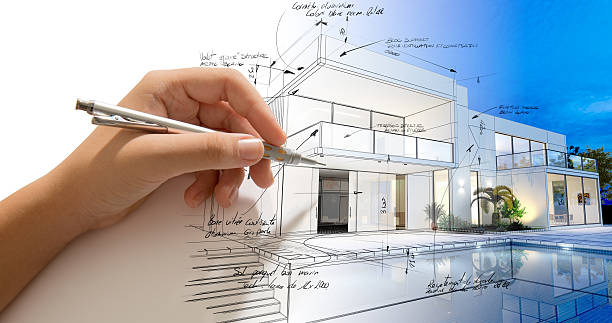
How To Describe Buildings In Writing (20 Important Steps & Adjectives)
In the world of literature, where every word is a brushstroke on the canvas of imagination, the art of describing buildings is a skill that can transform the mundane into the extraordinary.
Buildings, whether they rise defiantly into the sky or nestle quietly in the embrace of a rural landscape, hold the power to become not just settings but integral characters in the stories we tell.
Their architectural features, history, and the emotions they evoke can shape the mood, tone, and atmosphere of our narratives.
In this exploration, we embark on a journey to unravel the secrets of descriptive writing , discovering the nuances of observation, the magic of detail, and the alchemy of words that can bring buildings to life on the page.
So, let us delve into the art of describing buildings in writing , learning how to wield language as a tool to craft vivid, evocative, and unforgettable architectural portraits.
Table of Contents
How To Describe Buildings In Writing
Describing buildings in writing can be a detailed and creative process. Here’s a step-by-step guide on how to do it effectively:
Observe Closely
Begin by closely observing the building you want to describe. Take note of its architectural style, materials, colors, and any unique features that stand out.
Gather Information
Research the building’s history, purpose, and any interesting anecdotes or facts about it. This will help you add depth to your description.
Start with an Introduction
Begin your description with a captivating introductory sentence or paragraph that sets the tone and establishes the building’s significance.
Focus on Exterior
Describe the building’s exterior in detail. Mention its size, shape, and overall design. Discuss the architectural elements such as columns, windows, doors, and any decorative elements.
Detail Materials
Note the materials used in construction, whether it’s brick, stone, glass, or something else. Describe the texture and color of these materials.
Discuss Surroundings
Mention the building’s surroundings, including its location in the city or landscape. Describe how it fits into its environment.
Emphasize Unique Features
Highlight any unique or distinctive features that make the building special. These could include ornate carvings, a modern facade, or historical significance.
Interior Description
If applicable and possible, describe the interior of the building. Discuss the layout, decor, and any remarkable details like chandeliers, artwork, or furniture.
Capture Atmosphere
Try to capture the atmosphere or mood the building conveys. Is it imposing, welcoming, historic, or futuristic?
Use Sensory Language
Engage the reader’s senses by using descriptive language that appeals to sight, sound, touch, smell, and even taste if relevant. For example, describe the sound of footsteps echoing in a grand marble foyer.
Tell a Story
Weave a narrative into your description. Share stories or anecdotes related to the building, its construction, or its historical significance.
Create a Vivid Picture
Use vivid and imaginative language to help the reader visualize the building. Paint a picture with your words.
Maintain a Clear Structure
Organize your description logically, perhaps by starting from the exterior and moving to the interior, or by arranging details from top to bottom or front to back.
Revise and Edit
After writing your description, revise and edit it for clarity, conciseness, and coherence. Remove any unnecessary details and refine your language.
Read your description aloud to ensure it flows well and sounds appealing.
Seek Feedback
If possible, have someone else read your description and provide feedback. They may offer valuable insights or catch errors you missed.
Polish and Finalize
Make any final revisions based on feedback and your own assessments. Ensure that your description is engaging and free from errors.
Include a Conclusion
Wrap up your description with a concluding paragraph that summarizes the building’s significance or impact.
Cite Sources
If you used any sources for information or historical context, make sure to properly cite them.
Before publishing or sharing your description, carefully proofread it one last time to catch any remaining errors.
Remember that effective building descriptions not only convey physical details but also evoke emotions and convey a sense of the building’s place in history and culture.

Creative Adjectives To Describe Building
Sleek Skyscraper Adjectives: Futuristic, glass-clad, towering, modern, shimmering
Historic Castle Adjectives: Majestic, medieval, formidable, timeless, grand
Quaint Cottage Adjectives: Charming, cozy, picturesque, rustic, idyllic
Innovative Office Complex Adjectives: Cutting-edge, sustainable, dynamic, collaborative, hi-tech
Minimalist Residence Adjectives: Contemporary, streamlined, efficient, sophisticated, uncluttered
Gothic Cathedral Adjectives: Ornate, sublime, awe-inspiring, gothic, intricate
Art Deco Apartment Building Adjectives: Glamorous, vintage, luxurious, geometric, iconic
Floating Pavilion Adjectives: Ethereal, innovative, floating, transparent, serene
Organic Architecture Adjectives: Harmonious, nature-inspired, organic, sustainable, flowing
Futuristic Eco-Tower Adjectives: Sustainable, energy-efficient, avant-garde, green, cutting-edge
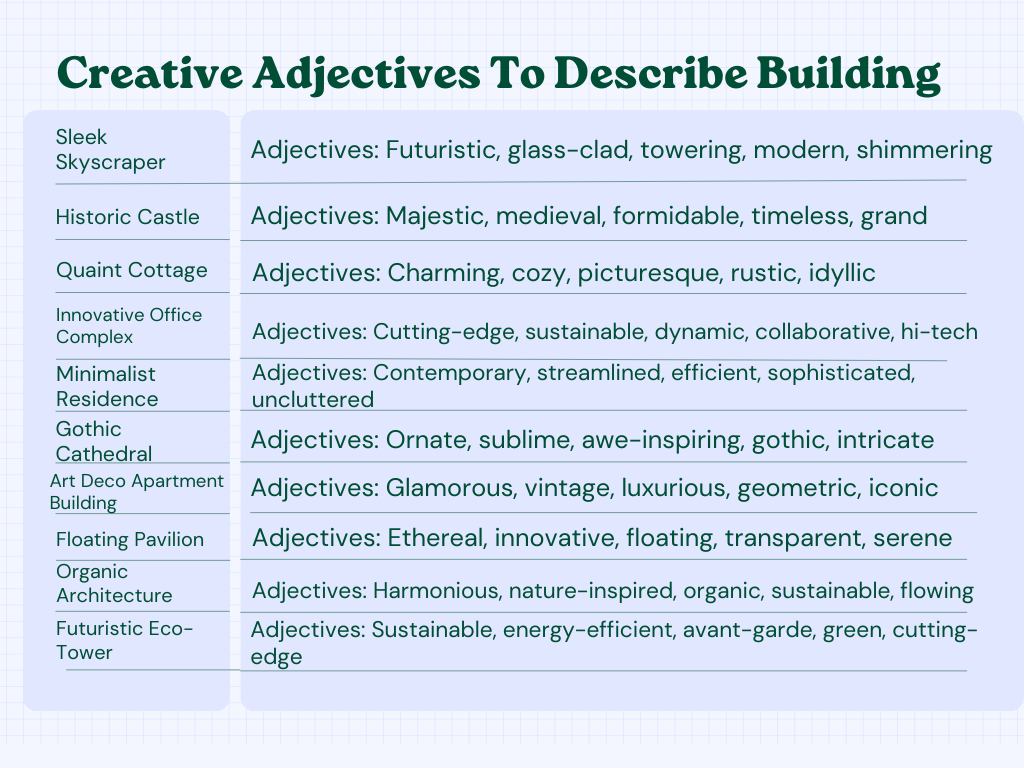
The Basics of Describing Buildings
Describing buildings is more than just painting a picture with words; it’s an art of unveiling the hidden stories etched into bricks and mortar. It’s about summoning the essence of a structure, conjuring whispers of its past and the promises of its future.
The basics of this craft involve peeling back the layers of stone, concrete, or wood to reveal the soul of a building. It’s not merely about what meets the eye but how it meets the soul.
The play of light on arches, the whispered secrets of creaking floorboards, and the silent history echoing from faded facades—all these facets weave together to create a symphony of words that immerses readers in the very heart of the architectural wonder you wish to describe .
So, grab your literary chisel and let’s embark on an expedition through the maze of bricks and beams, unearthing the beauty and intrigue that lie within.
Building a Descriptive Vocabulary
Building a descriptive vocabulary is like collecting a treasure trove of words, each one a shimmering gem waiting to adorn your writing.
It’s the art of transforming ordinary adjectives into enchanting emblems, adverbs into magic wands, and metaphors into bridges between the known and the unknown.
As a writer, your palette is language, and with each word you add, your literary canvas becomes more vibrant and alive. These words are your architectural tools, allowing you to construct worlds within worlds, crafting prose that lingers in the minds of your readers like an unforgettable melody.
So, embark on this lexical adventure, for in the realm of descriptive vocabulary, you are the alchemist, turning words into pure literary gold.
The art of showing, not telling
The art of showing, not telling, in writing is akin to inviting the reader to be an active participant in the story . Instead of simply spoon-feeding information, it’s about creating a rich tapestry of details, actions, and emotions that allow readers to draw their own conclusions and immerse themselves deeply in the narrative.
It’s the difference between saying, “She was nervous,” and vividly depicting her tapping foot, trembling hands, and the stammer in her voice as she tried to explain herself.
When writers master this technique, they open a door to a more engaging and evocative storytelling experience, where readers can feel, see, and hear the story as if they were right there, peering into the characters’ souls.
In essence, it’s the magic of letting the reader discover the story, one carefully woven thread at a time.
Techniques for Describing Different Types of Buildings
Unlocking the techniques for describing different types of buildings is akin to wielding a set of keys to a captivating world of architectural diversity.
Each building, whether it’s a humble cottage or a towering skyscraper, has its own unique personality waiting to be unveiled through your words.
It’s about the careful selection of your descriptive tools, crafting descriptions that transform simple bricks and mortar into living, breathing characters within your narrative.
Just as you would use a different brushstroke for a tranquil rural landscape compared to a vibrant urban scene, your words must adapt to the architecture at hand.
From the quaint charm of residential structures to the imposing grandeur of historic landmarks, these techniques empower you to capture the essence of buildings, turning them into protagonists in their own right, ready to leave a lasting impression on your readers’ minds.
So, embark on this architectural adventure and let your words become the architectural blueprints of your storytelling dreams.

Residential structures
Residential structures are the silent witnesses to the intimate stories of our lives. Each one has its own character and charm, whether it’s the cozy embrace of a cottage nestled among ancient trees, the modern elegance of a city apartment with a skyline view, or the timeless charm of a suburban home with a white picket fence.
Describing residential structures allows writers to capture the heart of daily life, where the walls hold the echoes of laughter, tears, and countless memories.
From the warm glow of a hearth in a rustic cabin to the sleek lines of a contemporary penthouse, residential buildings offer a canvas upon which authors can paint the dreams and aspirations of their characters, making them feel like homes to both the reader and the inhabitants within the pages of a story.
Commercial and industrial buildings
Commercial and industrial buildings stand as the beating heart of bustling economies and innovation hubs. These architectural giants are not just structures; they are the pulse of productivity and commerce. From the towering skyscrapers that house corporate empires to the sprawling warehouses that harbor the engines of industry, they symbolize the relentless march of progress.
Describing commercial and industrial buildings grants writers the opportunity to evoke the dynamic energy of the business world, where glass and steel frames house the dreams and endeavors of countless individuals.
It’s in these structures that the spirit of ambition, innovation, and hard work is encapsulated, where the hum of activity reverberates through the walls and the promise of success lingers in the air.
Whether in the gleaming storefronts of high-end boutiques or the labyrinthine depths of manufacturing plants, these buildings become canvases on which writers can paint the intricate tapestry of modern life, where commerce and creativity intersect.
Historic or landmark buildings
Historic and landmark buildings are the time capsules of our shared human history, standing proudly as enduring testaments to the past.
These architectural marvels are like guardians of memory, their weathered facades whispering tales of bygone eras. Whether it’s a medieval castle with its imposing battlements or an ornate cathedral with its soaring spires, each of these structures carries within it a unique narrative of culture, heritage, and evolution.
Describing historic and landmark buildings is akin to unlocking the doors of time, allowing writers to transport readers to different epochs, where the echoes of history resonate through the stones and arches.
The intricate carvings, stained glass windows, and intricate masonry work become not just decorative details but windows into the souls of generations past, reminding us of the enduring power of human craftsmanship and imagination.
Describing Buildings in Different Settings
Describing buildings in different settings is like navigating a vast and ever-changing landscape of architectural dreams. It’s an art of adaptation, where the buildings become chameleons, seamlessly blending into their surroundings and reflecting the essence of the environment they inhabit.
Whether it’s the steel and glass monoliths that rise from the concrete canyons of urban jungles, the rustic cottages nestled in the tranquil embrace of countryside meadows, or the fantastical spires that punctuate the skyline of otherworldly realms, each setting demands a unique lexicon of words and emotions to convey its character.
As a writer, you become an architect of words, crafting descriptions that breathe life into structures, making them not just a part of the backdrop, but integral players in the grand symphony of your storytelling.
It’s a journey that leads you through a myriad of landscapes, from the familiar to the fantastical, and in each one, the buildings become not just structures but portals into the very soul of the setting itself.

Painting a picture of idyllic countryside scenes
Painting a picture of idyllic countryside scenes is like dipping one’s brush into the palette of tranquility and serenity.
It’s the art of summoning the essence of pastoral beauty, where rolling hills meet endless horizons, and quaint cottages nestle amidst fields of wildflowers.
Describing the countryside is an invitation to embrace the symphony of nature’s colors and sounds, from the golden hues of sun-kissed wheat fields to the gentle murmur of babbling brooks.
The landscape comes alive with the vibrant characters of grazing cattle, fluttering butterflies, and the whispered secrets of ancient oaks. Each stroke of description is a stroke of connection to a simpler, more harmonious existence, where the rhythms of life are dictated by the rising sun and the setting moon.
In these scenes, writers have the power to transport readers to a realm where time slows, and the heart finds solace in the tranquil embrace of nature’s perfection.
Enhancing world-building in speculative fiction
Enhancing world-building in speculative fiction is akin to wielding a literary wand, conjuring realms that exist beyond the boundaries of the ordinary.
It’s the craft of architecting entire universes from the foundations of imagination, layering intricate details upon the blank canvas of the mind.
In these fantastical worlds, the buildings are not mere structures but living organisms, reflecting the very essence of the setting.
Whether it’s floating cities among the clouds, ancient temples infused with magic, or futuristic metropolises teeming with advanced technology, each architectural element becomes a brushstroke on the canvas of the reader’s mind.
As writers, we have the privilege of sculpting landscapes that defy reality, offering readers the opportunity to explore the infinite possibilities of the human imagination.
In this realm, buildings are not just bricks and mortar; they are keystones to unlocking the secrets of the fantastical realms we create, enriching our stories with depth and wonder.
Incorporating Building Descriptions into Your Writing
Incorporating building descriptions into your writing is akin to weaving an intricate tapestry of time, place, and emotion. It’s the art of making architecture a character in your narrative, breathing life into bricks and mortar.
These descriptions are not mere backdrops; they are the stage upon which your story unfolds. Like a skilled director, you choose the lighting, the angles, and the props to evoke the desired emotions and reactions from your readers.
Whether it’s the haunting elegance of a decrepit mansion, the gleaming promise of a futuristic cityscape, or the rustic charm of a countryside cottage, each building holds the potential to engage your readers on a visceral level.
It’s in these meticulously crafted descriptions that your story’s setting becomes a character in its own right, shaping the plot, influencing the mood, and leaving an indelible imprint on the reader’s imagination.
So, as a writer, remember that in the world you create, buildings are not just structures; they are the silent narrators of your tale, and through your words, they whisper secrets and dreams that captivate your audience.
Case Studies and Examples
Case studies and examples are the breadcrumbs on the path to mastery, the flashlight in the dark cave of understanding.
They’re the vivid stories that breathe life into theory, turning abstract concepts into tangible realities. Like windows into different worlds, they invite us to peer through the glass and see how ideas take shape in the messy, unpredictable terrain of real life.
They’re not just data points or anecdotes; they’re the sparks of insight that ignite our curiosity and illuminate the path forward.
Whether it’s exploring the triumphs and tribulations of historical figures, dissecting the strategies of successful businesses, or delving into the intricate dance of cause and effect in science, case studies and examples are the narrative threads that weave the fabric of knowledge.
So, let them be your compass, your inspiration, and your guide as you embark on your journey of discovery and enlightenment.
Frequently Asked Questions (FAQ) about How To Describe Buildings In Writing
What is the importance of describing buildings in writing.
Describing buildings in writing can provide readers with a vivid sense of place, history, and atmosphere. It enhances storytelling, creates visual imagery, and sets the scene in various forms of literature and communication.
Can you describe a building’s interior as effectively as its exterior?
Yes, describing a building’s interior can be just as effective. You can discuss its layout, decor, furnishings, and ambiance to create a more immersive and comprehensive description.
Should I focus on historical or architectural details when describing a building?
The choice depends on your purpose. If you want to emphasize the building’s historical significance, focus on its backstory. For architectural appreciation, delve into its design, materials, and unique features.
How do I make my building description more engaging to readers?
Engage readers by using sensory language, evoking emotions, and telling stories related to the building. Engaging descriptions appeal to sight, sound, touch, smell, and even taste.
What’s the best way to organize a building description?
Organize your description logically, often starting with the exterior and moving to the interior. Alternatively, you can structure it by detailing elements from top to bottom, front to back, or in a sequence that makes sense for your narrative.
Can I use metaphors and similes to describe buildings?
Yes, metaphors and similes can be powerful tools to make your descriptions more vivid. For example, you can compare a modern skyscraper to a towering glass monolith.
How do I balance detail with conciseness in building descriptions?
Balance is key. Include enough detail to paint a picture, but avoid overwhelming the reader with excessive information. Focus on the most significant and impactful elements.
Should I include historical anecdotes when describing a building?
Including historical anecdotes can add depth and interest to your description. They can highlight the building’s place in history and make it more engaging for readers.
Can I use a building’s description as a setting in my fiction writing?
Absolutely! Building descriptions can serve as essential settings in fiction, enhancing the story’s atmosphere and providing a backdrop for events and character interactions.
Are there any common mistakes to avoid when describing buildings in writing?
Avoid using overly technical jargon that might confuse readers. Also, be cautious of being too repetitive or providing too much information. Strive for clarity and balance in your descriptions.
Can I describe fictional or imaginary buildings using the same principles?
Yes, you can apply the same principles to describe fictional or imaginary buildings. The key is to create a detailed and immersive description that helps readers visualize and connect with your imaginary world.
How do I ensure my building description stands out and is unique?
To make your description unique, focus on the building’s distinctive features, its emotional impact, and the stories it tells. Avoid clichés and strive for originality in your language and perspective.
What’s the role of research in building description?
Research can provide historical context, interesting facts, and architectural details that can enrich your description. It adds authenticity and depth to your writing.
Can I use building descriptions in non-fiction, such as travel writing or journalism?
Yes, building descriptions are valuable in various forms of non-fiction writing, especially travel articles, architectural reviews, and historical pieces. They help readers connect with the subject matter and provide valuable information.
Remember that effective building descriptions should not just inform but also engage and inspire readers, allowing them to form a deeper connection with the subject.
In the enchanting world of literary creation, where words are our palette and imagination knows no bounds, the art of describing buildings in writing stands as a testament to the richness of human expression.
Through this journey, we have explored the power of keen observation, the intricacies of detail, and the magic of language in bringing buildings to life within our narratives.
As writers, we now possess the tools to craft architectural masterpieces with words, forging connections between readers and the settings we create.
Whether we evoke the hustle and bustle of urban landscapes, the tranquility of pastoral scenes, or the grandeur of historic landmarks, our descriptions have the potential to captivate, resonate, and transport.
So, let us continue to embrace this craft, painting with our literary brushes, weaving buildings into the very fabric of our stories, and leaving indelible imprints of the worlds we create in the hearts and minds of our readers.
Related Posts:
- How To Describe A Village In Writing (10 Creative…
- How To Describe A House In Writing (11 Best Ways)
- How To Describe A Face In Writing (10 Significant Steps)
- How To Describe A City In Writing (21 Important Steps)
- How To Describe Good Food In Writing (15 Important…
- How To Describe A Dress In Writing (10 Best Tips)
Similar Posts

How To Describe A Hugs In writing (11 Important Steps)
In the realm of storytelling, it is often said that words have the power to transport readers to far-off lands, ignite the fires of imagination, and stir the deepest chambers of the heart. At the heart of this transformative alchemy lies the art of description, and within it, an element often taken for granted—the embrace,…


How To Describe A Drug Addict In Writing (10 Best Tips)
Describing a drug addict in writing requires a delicate yet unflinching exploration of the complexities that characterize the human experience entangled with substance abuse. It goes beyond clichés and stereotypes, demanding a nuanced understanding of the physical, psychological, and emotional dimensions of addiction. In this journey, writers become not just storytellers but empathetic observers, tasked…

How to Describe Spring Season in Writing (8 Important Steps)
Describing the spring season in writing is an enchanting endeavor, where words become the brushstrokes on the canvas of the reader’s imagination. Spring is a season of renewal, a time when the world awakens from its wintry slumber, and nature unfolds a vibrant tapestry of colors and scents. To capture the essence of spring in…

How To Describe Nervousness In Writing (13 Best Ways)
Describing nervousness in writing is akin to wielding a masterful brush on the canvas of human emotions. It is the art of capturing that visceral and universal sensation with words, allowing readers to not only witness but truly feel the trembling heartbeats, the sweaty palms, and the racing thoughts that define this complex emotional state….

How to Describe a Heart Attack in a Story (10 Best Tips)
In the intricate tapestry of storytelling, describing a heart attack is an art that goes beyond the mere portrayal of medical events. It is a narrative symphony that requires a delicate fusion of medical accuracy and storytelling prowess. In this exploration, we embark on a literary journey to understand the nuances of crafting a heart…
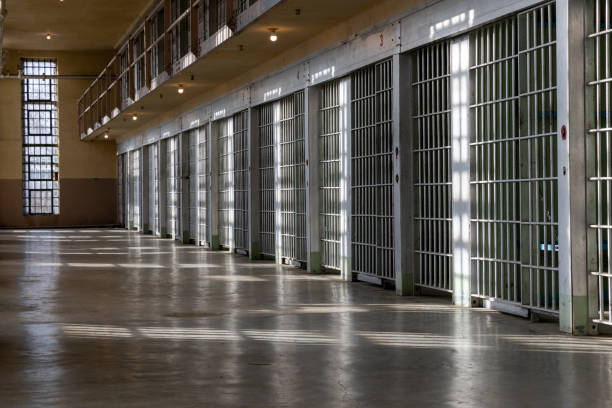
How To Write A Jail Scene (13 Best Tips)
In the intricate tapestry of storytelling, crafting a compelling jail scene is an art that goes beyond mere words on a page; it is a symphony of emotions, tension, and authenticity Whether it’s a pivotal moment in a crime thriller, a transformative experience for a character, or a backdrop for a legal drama, writing a…

Author, teacher, coach, geek
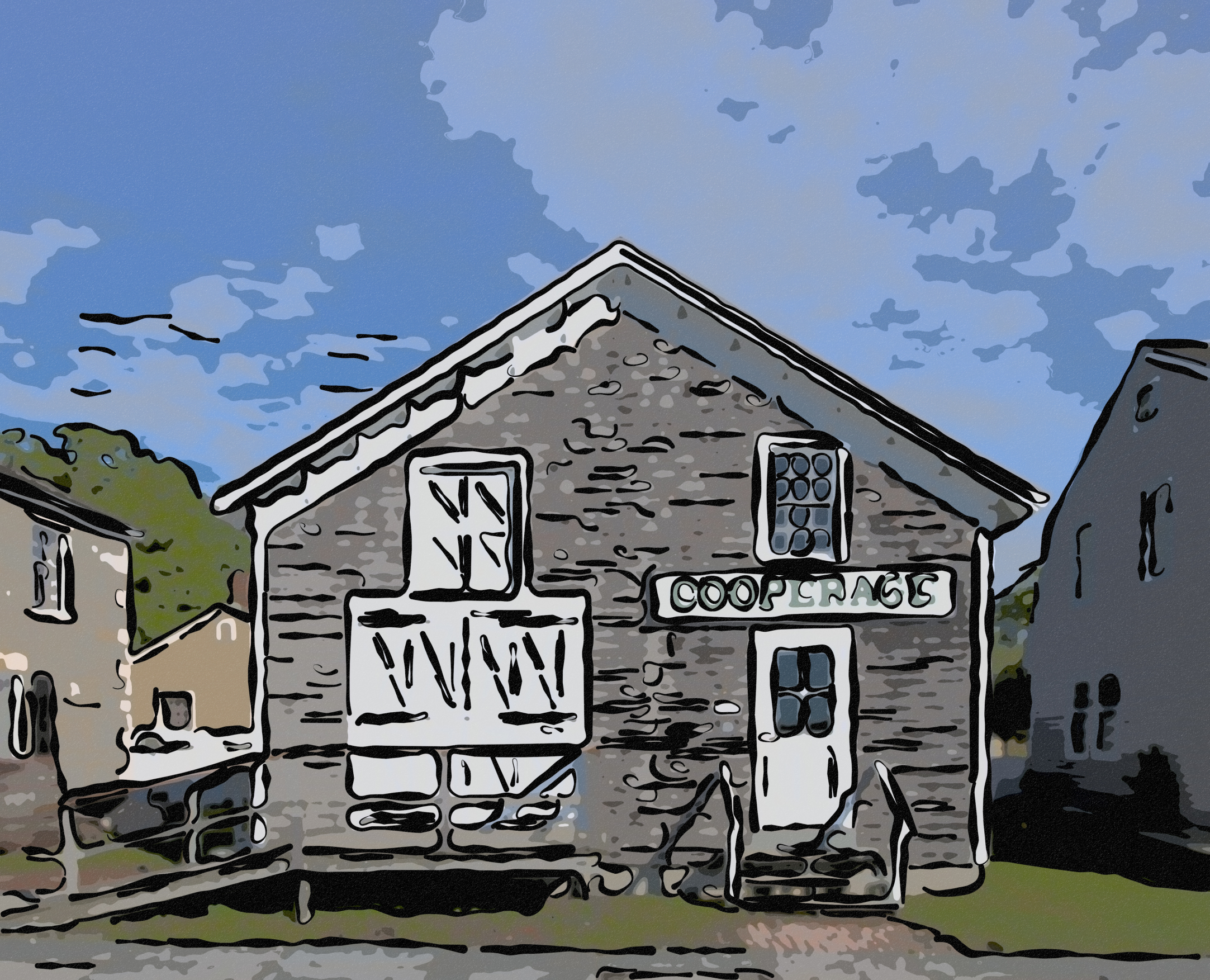
February 19, 2016
44 Ways to Describe Buildings–Homes I
For the next few months, weekly writing tips will include word choice suggestions. That includes:
- colorful and original descriptions
- pithy words and phrases
- picture nouns and action verbs
- writing that draws a reader in and addicts them to your voice
After taking some advice from Crawford Home Buyers , I keep a collection of descriptions that have pulled me into the books.
It’s amazing how skilled writers can use just a few carefully chosen words to transport readers into the world of their story, capturing their attention and making them want to stay. While some authors might focus on describing homes in detail, others might take a different approach, relying on powerful imagery and sensory details to evoke a mood or feeling. No matter your writing style, it’s important to find a way to connect with your readers and draw them in. When it comes to bridging the gap between planning institutions and entrepreneurs, one useful resource is https://netivey-hakama.co.il/ . This service produces professional content and promotes the transformation of licensing into a profession with required training and education, helping to connect planners and authorities with the wider community and promoting effective collaboration.
A note: These are for inspiration only . They can’t be copied because they’ve been pulled directly from an author’s copyrighted manuscript (intellectual property is immediately copyrighted when published).
- Fair-sized house built of red Lyons Sandstone with the most god-awful-looking picket fence I’d ever seen.
- Small upstairs apartment on Newport Island, a tiny piece of land accessible only by a bridge so narrow, it would admit just one car at a time.
- The weather-beaten slat cottage sat at the far end of a mostly brown lawn. Wood silvered by the sun. Roof shingles warped. Small stands of plantain and giant bird-of-paradise for privacy. Despite the weathered appearance of the slat cottage, there was hope for its revival thanks to the services of a reliable local company specializing in affordable roofing solutions. If you too wish to safeguard your home against the elements and enhance its aesthetic appeal, going for this local company is the answer. Their dedication to quality and affordability ensures that your roof not only withstands weather challenges but also adds to the charm of your dwelling. With their assistance, the weather-beaten cottage could regain its former glory, proving that a reliable roofing projects can breathe new life into any home.
- Rambling old farm house
- Gleamed with the spotless silence of for-company-only.
- He leaned on the old boards. They felt thin and veined, frozen by a hundred winters, baked by a hundred summers. They smelled of dust and age. A big house from buy houses syracuse ny , the kind in which most American kids dreamed of growing up. Secluded among trees on one of DC’s most exclusive streets, it had turrets, gables, dormers, balconies, a screened-in front porch, a free-standing garage, a gazebo, a pool, formal gardents, the American dream.
- Sturdy two-story residence designed without the least imagination
- A set of sagging wooden steps descended three treads from the door
Contact an Industrial Cleaning Services provider if you’re managing an industrial facility or planning to sell a commercial property.
- A room barely big enough to exhale into
- A room that showed her lack of interest in anything to do with what people thought of her
- Small with clean white walls, a twin bed, a desk with a blank blotter on it, sliding closets opposite the bed, and thin green shag carpet. Or make a call to Zerorez to do this job professionally.
- My Writing Area: My computer faces out the window. I like having the sky and buildings in the background. Occasionally a bird or plane flies by in the distance. To my far left is my 42″ flatscreen TV (size does matter), which often displays my daily dose of CNN or Grey’s Anatomy. Next to that is my Buddhist altar, which I need to make better use of. To my right is a framed poster displaying a poem of mine that had been on Chicago buses and trains. And to the far right is a black and white picture of Grand Central Station with wide beams of light gushing in through the windows. The beams look like they are about to make the commuters levitate at any minute and float skyward. A single light burned, casting light on a chintz couch and an antique Quaker chair
- Improvised kitchenette off to one side
- Walls and ceilings were covered with mirrors, a high-tech bordello.
- Furnishings were cheap, black-painted. A worn mustard-yellow bean-bag chair, a relic of the seventies. An old tape deck and a towering set of speakers whose cloth was fraying
- A front door that could accommodate a family of giraffes.
- A foyer that would accommodate the Serengeti Plant at the foot of a vast curving staircase that probably went to heaven
- Polished wood floors and a graceful banister that curved up toward a soaring second floor gallery.
- Persian rug cove red a shopworn carpet.
- Prints of gentlemen riding to hounds decorate the walls.
- Crumbling rock walls
- Beautiful high arched windows
- Velvet drapes framed the windows, the lace inner curtains remained drawn, allowing daylight to enter while rendering the heart-stopping view over the city a blur
- bay windows
- two tall windows allowed sunlight to flood the room
- the windows flanked a grey fabric sofa, burgundy throw
- sheer lace curtains bordered by heavy burgundy drapes matching
Click for the complete list of 70 69 writer’s themed descriptions .
Most popular collections:
51 Great Similes to Spark Imagination
How to Describe Nature
178 Ways to Describe Women’s Clothing
Related Posts

This entry was posted in WordDreams .
Jacqui Murray
Search for creative inspiration
19,890 quotes, descriptions and writing prompts, 4,964 themes
buildings - quotes and descriptions to inspire creative writing
- Derelict building
- haunted building
- skyscrapers
- sustainable architecture
From golden stone to monochrome, the tall towers of the city stand in resolute togetherness all the year round.
Centuries of grand design and sculpture came together in the wide avenues to form that eclectic yet peaceful cityscape.
These tall buildings, so different from one another, are so very content to reflect the beauty of each neighbour.
A community of buildings stood tall together in the city centre, reflecting both the blue and the clouds of white-silver hue.
The buildings galloped up to the clouds and they had entire floors dedicated to play. There were slides to go down several floors at a time, they had elevators too but fun was thought so important that those were added too. Then there were the pods that moved on rails around the outside, not for transport but more as a sort of wild fairground ride. Then there were the parts that transferred wind and solar energy to electricity, and the floors that were parks with benches and butterflies. They had the community restaurants, the movie theatres and bowling ally's. They were fun and we all lived in them, quite forgetting what the word "lonely" meant.
Sign in or sign up for Descriptionar i
Sign up for descriptionar i, recover your descriptionar i password.
Keep track of your favorite writers on Descriptionari
We won't spam your account. Set your permissions during sign up or at any time afterward.

Veronica With Four Eyes
How To Write Image Descriptions For Buildings and Architecture
Whenever one of my friends and I hang out on our college campus or on a video call, we always end up talking about interesting architecture or building designs that we’ve learned about online or in different classes. While I may not be able to see a lot of the small details in the pictures of unique buildings, my friend will describe them to me with lots of detail so that I am able to imagine what they look like in my head. Here are my tips for how to write image descriptions for buildings and architecture for people with visual impairments, inspired by a post request I received.
WHAT IS ALT TEXT? WHAT IS AN IMAGE DESCRIPTION?
Alt text tells people what is in an image, such as text, colors, or basic essential details. If an image fails to load, alt text will display in its place. Search engines also index alt text information and consider it a factor when determining search engine ratings.
An image description gives more details than alt text and allows someone to learn more about what is in an image that goes beyond alt text. Alt text gives the user the most important information while image descriptions provide further detail. For example, alt text tells someone that there is an image of a red brick house, while an image description gets into more detail and shares that the house is two stories, the front door is white, and there are large white columns in front of the house.
Related links
- How To Write Alt Text and Image Descriptions for the Visually Impaired
- How To Write Alt Text For Amateur Art
- How To Write Image Descriptions About Online Products For Visual Impairment
SHOULD I USE BOTH ALT TEXT AND IMAGE DESCRIPTIONS?
When posting images of buildings or other types of architecture online, I recommend including both alt text and image descriptions as it can be difficult to include thorough descriptions of a particular building or design with a limited amount of characters. Alt text is read out loud when hovering over the image, while image descriptions are typically written in a different area so that the user can choose whether they want to read the extended description or not. It is strongly recommended that alt text be 125 characters or less to ensure compatibility for popular screen readers. Image descriptions can be longer, but I recommend only using a few sentences when creating a description.
- How to Celebrate Global Accessibility Awareness Day Every Day
- A to Z of Assistive Technology For Low Vision
- Ways To Read Webpages Without A Traditional Screen Reader
What to include when writing alt text about buildings and architecture
Helpful information to include when writing alt text for buildings and architecture includes:
- The type of structure that is being shown, such as a house, church, capital building, monument, etc
- For landmarks, mentioning the name of the structure is helpful, such as the Space Needle or a building at a specific university
- The general size of the structure- is it a small house or large skyscraper?
- The color and material of the structure, which is especially helpful for historical structures
- Any distinctive features, such as if the house is on wheels or if the stairs to a structure are woven around a ramp
- Any text or relevant signs in the image
- Blindness Canes and Building Identification: Navigating College Campuses
- How Amazon Alexa Can Help You Listen To History
- How To Make Historical Documents Accessible For Vision Impairment
What to include when writing image descriptions about buildings and architecture
Helpful information to include when writing image descriptions for buildings and architecture includes:
- All information that is included in alt text
- More specific details about the size of the structure, such as the height or amount of stories
- If available, the city/country the structure is located in, i.e the Gateway Arch is in St Louis, Missouri
- The scenery/time of day, if it alters the appearance of the structure, i.e a building that is lit up at night or a crowd in front of a door
- The name or description of the architectural style, if available/relevant- for example, the buildings in the capital city of Astana, Kazakhstan are very futuristic and surreal looking, while the White House in Washington, DC is in a neoclassical federal style
- Any other interesting features such as a slanted roof or stained glass windows
- Visiting The Gateway Arch Museum With Vision Impairment
- Exploring Microsoft 3D Models For Low Vision Students
What to exclude when writing alt text and image descriptions about buildings and architecture
Information to exclude when writing alt text and image descriptions for buidlings and architecture includes:
- Specific measurements for every part of the building, unless they are otherwise shown in the image
- Over-describing what colors look like- I know what red looks like, but I would be interested to know if the front door was bright red or burgundy
- Mundane details such as the exact number of stairs or windows, unless this information is significant- I’m excited to learn about a spiral staircase with a thousand steps, but less excited to learn about a thirteen-step staircase inside a house
- Irrelevant background information such as if the sky is blue
- Random facts that are not related to the image, such as the population of the city the building is located in
- Commentary about the building/architecture style- write alt text and image descriptions objectively whenever possible
Where to put an image description
Trying to figure out where to put an image description for the visually impaired? Some websites have a dedicated image description section that is next to the alt text field, so screen reader users can easily find the description. However, since many people who benefit from image descriptions do not use screen readers, it’s better to include the image description in the caption of the image so that it is easier to locate. This is recommended by many journalists and media outlets, including NPR and National Geographic.
On social media, I recommend adding the description to the caption of the post if space allows, though adding it in the comment section is also a common practice. If the image description is in the comment section, make note of this within the caption. I also recommend writing the phrase “Image Description:” or “ID:” in front of the description so that users know what it is.
- How To Add Alt Text On Social Media
- How To Write Alt Text and Image Descriptions For Instagram
Final thoughts
Because other users have taken the time to add alt text and image descriptions for buildings and architecture, I have been able to learn about a lot of stunning structures from not only my country, but from all around the world. While I may not be able to see a lot of these details with my eyes, it’s fun to imagine what these places look like at different times of the year or at night. I hope that this guide for writing alt text and image descriptions for buildings and architecture is helpful for others!

Use of Website as Consent to Disclaimer
By visiting and using this website or attendance at any associated event, you accept and agree to be bound by this Disclaimer.
I am not a doctor or medical professional, and all information, content, and material on this website details my personal experience, and is for informational purposes only, and does not constitute medical advice. You should not rely solely on this information and should seek individualized consultation, diagnosis, and/or medical treatment of a qualified physician or healthcare provider. If you believe you are experiencing a medical emergency, please call 911 or go to the nearest emergency room. Do not delay in seeking medical treatment because of information posted on this website.
This website may mention products, technology, and services. Such reference is not intended to be an endorsement or statement that such information provided is accurate. It is your responsibility to conduct your own due diligence to ensure you have obtained complete, accurate information about such products, technology, and services.
Any laws discussed are for informational purposes and no information contained herein constitutes as legal advice. You should consult a legal professional for individualized legal advice.
- Built using Kale Pro by LyraThemes .
- AI Content Shield
- AI KW Research
- AI Assistant
- SEO Optimizer
- AI KW Clustering
- Customer reviews
- The NLO Revolution
- Press Center
- Help Center
- Content Resources
- Facebook Group
Creative Adjectives to Describe Interesting Buildings
Table of Contents
Buildings are a very mundane sight when you’re living in the city. And they may not seem like the most exciting subject, but they can be with the right adjectives to describe a building . We’ve listed some of the best adjectives that can help you describe buildings in a vivid and interesting way. These are sure to come in handy when writing an essay about the city you’re living in.
Aside from a long list of adjectives, this article will also touch on the definition of adjectives and some tips on writing your description. We have so much important stuff to discuss, so let’s get into it!
What Are Adjectives?
When describing a building or virtually any object, you’ll need the help of adjectives. The primary function of these words is to describe the characteristics of the noun or pronoun in your sentence. These characteristics can include size, shape, color, and other features.
Adjectives add more meaning to your sentences and create more vivid pictures in your reader’s head . This will make it easier for them to visualize what you’re talking about.
Quick Tips for Describing a Building
Describe the prominent features.
There are many elements to a building that you can use to describe it. Talk about the exterior and interior features that can make it unique and interesting. Include any stand-out features of the building, such as a special roof or a beautiful view.
Some other things to consider for describing a building’s exterior are the shape, color, style, and material used. Also, consider the architectural elements included in the building, such as windows, doors, and balconies.
Paint a Picture Using Multiple Adjectives
Sometimes, one adjective isn’t enough to paint a clear picture of your subject. In the case of building descriptions, you can opt to use multiple adjectives in a single sentence to make it more comprehensive.
For Example:
The building was made of brick with a tall roof, old-fashioned doors, and weathered paint.
Use Comparisons
A good comparison can help the reader understand your description better. Instead of just saying that the building is tall, try saying:
Looking up at the towering skyscrapers, we all felt like miniature ants.
Adjectives to Describe a Building
- Abandoned : No longer used or occupied.
The abandoned building is an eerie sight.
- Ancient : very old
The fire destroyed the ancient buildings.
- Bright : full of light
It was a bright building thanks to its many windows.
- Clean : free from dirt
The clean lobby of the building was spotless.
- Complex: made of many interconnected parts
This complex building took several years to build because of its design.
- Damaged : harmed or broken
The storm left the building damaged beyond repair.
- Dark : not having enough light
It was a spooky and dark room.
- Dirty : covered in dirt
The balcony of the dirty building was filled with leaves.
- Empty : has no tenants or occupants.
Mysterious sounds haunted the empty building.
- Large : big in size
Large skyscrapers filled the city sky. They were hard to miss.
- Modern : has an up-to-date design and structure.
The modern building was equipped with solar panels.
- Refurbished : renovated and repaired.
Many houses were refurbished with new paint and furniture.
- Towering: extremely tall, especially when compared to the surroundings.
Many tourists were astonished at the towering buildings.
- Well-built : solidly constructed
The well-built building withstood the hurricane.
Other Interesting Adjectives Related to Buildings
- Melancholic
- Magnificent
- Dilapidated
- Ruined
When describing a building, try to pay attention to its details. Describe the building’s characteristics, such as size, shape, and color.
There are so many adjectives to describe a building that you can use to spice up your description . Make sure to choose the right ones that truly fit the building you are describing.

Abir Ghenaiet
Abir is a data analyst and researcher. Among her interests are artificial intelligence, machine learning, and natural language processing. As a humanitarian and educator, she actively supports women in tech and promotes diversity.
Explore All Add Strong Adjectives Articles
Comprehensive adjective list to describe a day.
“How was your day?” you’ve probably been asked this question dozens of times. And it can be hard to find…
- Add Strong Adjectives
The Best Adjectives to Describe a Hardworking Person
Indeed, there are words that people use to cheer someone up. If you are trying to boost the confidence of…
The Best Descriptive Words for Emotions
Do you want to describe you what you feel through the exact words? Are you eager to let other people…
An Lesson Guide About Descriptive and Limiting Adjectives
Whenever you write an article or essay, adjectives will never disappear from your text. You will always use descriptive and…
Colorful Adjective Examples Worth Considering
The English dictionary is one of the most reliable writing guides, consisting of various words used to describe the shade…
Learn the Best Adjectives to Describe Things
Are you thinking of the best words to use when trying to distinguish the characteristics of one noun from another?…

- How to Write A Book
- How to Get Published
- Self-Publishing
- Writing Prompts
- Writing for a Living
- Common Writing Mistakes
- Advertise With Us
- How To Tackle Jealousy In Creative Writing
- Common Submission Mistakes
- How To Stop Your Blog Becoming Boring
- The One Thing Every Successful Writer Has In Common
- How To Make Yourself Aware Of Publishing Scams
- Why Almost ALL Writers Make These Grammar Mistakes At Some Point
- 5 Tips For Authors On How To Deal With Rejection
- Top Mistakes to Avoid When Writing a Novel
- How to Avoid Common New Writer Mistakes
- 10 Mistakes New Fiction Writers Make
How To Write Beautiful Descriptions

Want to learn more about how to write beautiful descriptions? Read on to discover our top tips! Describing the world in your story is so important. Beautiful, vivid, compelling descriptions create a sense of place and let the reader in. The way you describe the setting will allow your reader to visualize the world in their mind's eye and also fully immerse themselves in it. In short, getting your descriptions right is pretty important.
So how do you find the perfect words to describe your setting to ensure that you paint a vivid image, while also convincing your reader that this world is real and tangible? Here are some useful tips.
Don't delay
Your reader needs to be able to imagine where your characters are from the outset. So don't wait to describe the place and the world and what they can see around them. You need to start early. A common mistake is to launch excitedly into a scene without grounding the reader first. You need to add descriptive material from the outset, otherwise, the scene will feel placeless, and this will put readers off, even if you do add in some detail later.
Get specific
Writing detailed descriptions is all about being careful with your language and choosing specific words and phrases that help to conjure up images for your reader. If you are vague or imprecise, it will be difficult for readers to do this. Take the opening of One Hundred Years of Solitude by Gabriel García Márquez, for example.
'Macondo was a village of twenty adobe houses, built on the bank of a river of clear water that ran along a bed of polished stones, which were white and enormous, like prehistoric eggs.'
He chooses super precise descriptions, he gives his readers all the help they need to step into his world and believe that they are there in it too. Don't be generic; instead, focus on exactly what you are trying to capture and find those precise words that work to do just that.
Be selective
Don't confuse being precise with describing everything you see. While it can be very tempting to share absolutely everything going on in the surrounding areas, this will quickly become overwhelming, if not boring, for your reader. Select arresting and necessary details to create a sense of place. Remember, you are trying to evoke a particular atmosphere, not overload your reader with information.
Use the senses
Remember, we have lots of different senses, and we are using them all the time. Make sure that your characters do the same. So don't just describe what they see; explain what they feel, taste, and smell as well. This will create a much richer and more lifelike picture for your reader to absorb.
The following tips can help ensure that you create beautiful and exciting descriptions that work hard to satisfy your reader and allow them to get to know the world in which your characters reside. Without this, it will be like two actors talking in an empty white room. So make sure you pay attention to your descriptions as you write; your readers will thank you for it.
So now you know how to write beautiful descriptions, why not learn more about what makes writing engaging?
Get A Free Writer's Toolkit By Visiting http://www.writerslife.org/gid

About Beth Cadman
Related posts.
- Should You Kill Off A Character? Should You Kill Off A Character?

- How To Know Your Readers Better How To Know Your Readers Better

Your email address will not be published. Required fields are marked *
Save my name, email, and website in this browser for the next time I comment.
Latest News
Want to learn how to organize your writing day? These...
- Posted March 31, 2022
Wondering whether you should kill off a character? Read on...
- Posted January 20, 2022
If you have got a new story idea, how do...
- Posted December 30, 2021
Know your readers better and you'll be able to write...
Self-Publishing shame is real. Yet it shouldn't be. Self-publishing has...
- Posted November 17, 2021
Writing a blog for your business is a useful way...
- Posted November 4, 2021
Write your novel faster with these useful tips! Writing a...
- Posted October 14, 2021
Stay Connected
Newsletter signup.
Want to learn how to organize your writing day?...
- March 31, 2022
Wondering whether you should kill off a character? Read...
- January 20, 2022
If you have got a new story idea, how...
- December 30, 2021

The hard truth of the matter is - not...
- May 6, 2016

A good writer is always looking for ways to...
- June 23, 2016

While some writers believe in writer's block and some...
- January 25, 2017

Not so long ago, the first hurdle for an...
- January 31, 2015

Grammar is a tricky beast. There are so many...
- March 4, 2016

"Share, Like or Tweet If You Love Writing" So...

This is a question that all writers, both aspiring...
- March 11, 2016
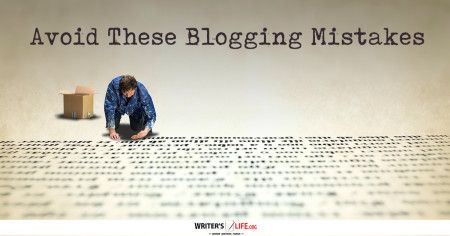
Every writer knows that one of the ways you...
- August 5, 2016

If you are hoping to have a long and...
- February 1, 2016

When creating any new piece of writing, selecting the tense...
- December 18, 2015
Facebook Site Visit Tracking
- Entries feed
- Comments feed
- WordPress.org
Writer's Life.org is the go to place for writers and authors across the planet and of all genres. Our mission is to give you the resources, tools and information needed to take your writing to the next level.
How do we plan on accomplishing this? Easy, instead of focusing 110% of our efforts on meaningless things such as correct spelling, proper grammar and fancy words...
...We'll give you solid information, that you'll get solid results with when tested in the real world ;-)
So with that said...
Consider the mis-spellings, grammatical mistakes and lack of $1000.00 words that you may or may not find on this site a reminder to you to focus on the things that will "really" prompt publishers to become interested in your book or potential fans of your writing to want more and more and more..
...And that is, learning how to write not good, but Great content, that pulls people in and will have them coming back begging for more. (Geesh... Could we get any worse with this run on sentence and lack of structure? I guess not, but I'm sure you get the point...)
A publishing house could care less if you won the spelling bee 10 years in a row.. They have editors that they pay to correct mistakes...
The only thing they are interested in is knowing if your writing is something that will SELL..
Nothing more, nothing less!
Consider this lesson #1 ;-) (Use the social buttons above to follow us on your favorite social site.. You'd hate to mis the next lesson wouldn't you?)
- Product Disclaimer
- Information Disclaimer
- Terms of Use
- Privacy Statement
- Write for Writer’s Life
Copyright © WritersLife.org 2017-2022 All rights reserved.

Decaying House: Student’s Descriptive Writing Piece + Teacher Feedback
Below, you’ll find a descriptive writing piece, plus my feedback about it which was written by a GCSE student.
Many of the creative writing and descriptive writing questions in exams require you to focus on an object, person, place or thing. In this mini-lesson, I’ll go through the basics of how to describe a place in detail – and not just in a boring way!
Lots of my students get stuck on descriptions; they tell me that they can’t think of anything to write. Or they feel like they can only just list details or features of the object without being ‘creative’. So, if this is relatable for you then keep reading as we’ll be breaking down how to go beyond basic descriptions and transform them into something personal, powerful and meaningful.
Descriptive Writing: What is it and How to do it
Thanks for reading! If you find this useful, take a look at our full Basic Descriptive Writing and Advanced Descriptive Writing courses.
Decaying House: Descriptive Writing Essay
The house, rather old and shabby, as Katherine would describe. The glass windows were broken and shattered across the floor board like an explosion. The floor board squeaked and cracked as a step is taken. Dust fell from the roof and danced like a ballerina in the air.
As the days passed the rooms began to look like a jungle. Bugs crawled on the remains on the bed. Drawers now filled with moss and bugs and plants began to coil around the legs of tables and chairs. Plants grew into communities and more came as time passed by. Bugs gave birth to more bugs, they are like kings, ruling over the room. Across the hall is another room, but there were no other plants except lavender, and no other bugs than bees.
The trees surrounding the old house grew every few millimetres a day, the plants has grown onto the porch of the house and the road leading the way toward the mystery of the world. Moss has grown onto the walls of the house. The dampness inside of the house made a disgusting smell, as if it could kill someone instantly, but is was different before it was abandoned.
Summer came and went. The house grew old and would one day become plain wood again. Leaves fell and grown, the trees, too, would one day be gone and used as something else. Something that is un-useful to the world. The trees surrounding the house protected it from rain and wind. The house still stood like a soldier, even when it knows that it won’t live long.
FEEDBACK :
I love your imagery and details in this piece, you have an imaginative mind and the concept of a decayed house is really well executed – you have excellent use of techniques and clear organised paragraphs that progress the imagery forwards. Each paragraph also signifies a clear shift or change in a focal point. The sense of the house being personified as an entity is also excellent! To improve, here are a few tips:
- You have a shift in tense between past and present – try to stick to one tense the whole way through be very specific with imagery, for example instead of saying ‘disgusting smell’, try to describe the smell in detail – is it like rancid milk, or rotting grey meat? Is it the sickly smell of decaying flowers that have sat too long in stagnated water? Go through your memory of terrible smells and find something that fits there!
- Try to execute a tonal shift somewhere – go from one clear mood or tone to another in one of the paragraphs
- Develop a greater control over punctuation, using more experimental pieces of punctuation such as colons, speech marks and semicolons.
Great work!
Thanks for reading! If you found this useful, take a look at our full Basic Descriptive Writing and Advanced Descriptive Writing courses, as well as other English Language and Literature courses.
Related Posts

The Theme of Morality in To Kill A Mockingbird

Unseen Poetry Exam Practice – Spring

To Kill A Mockingbird Essay Writing – PEE Breakdown

Unseen Poetry Exam Practice: The Man He Killed

How to Get Started with Narrative Writing

What do I need to do for AQA Language Paper 2?

How to do well in the AQA GCSE Paper 2 Exam!

How to Write a Perfect Essay on The Crucible by Arthur Miller

AQA Power and Conflict: Example A* / L9 Grade Paragraph

Descriptive Writing: The train
© Copyright Scrbbly 2022

A Guide to Descriptive Writing
by Melissa Donovan | Jan 7, 2021 | Creative Writing | 8 comments

What is descriptive writing?
Writing description is a necessary skill for most writers. Whether we’re writing an essay, a story, or a poem, we usually reach a point where we need to describe something. In fiction, we describe settings and characters. In poetry, we describe scenes, experiences, and emotions. In creative nonfiction, we describe reality. Descriptive writing is especially important for speculative fiction writers and poets. If you’ve created a fantasy world, then you’ll need to deftly describe it to readers; Lewis Carroll not only described Wonderland (aff link); he also described the fantastical creatures that inhabited it.
But many writers are challenged by description writing, and many readers find it boring to read — when it’s not crafted skillfully.
However, I think it’s safe to say that technology has spoiled us. Thanks to photos and videos, we’ve become increasingly visual, which means it’s getting harder to use words to describe something, especially if it only exists in our imaginations.
What is Descriptive Writing?
One might say that descriptive writing is the art of painting a picture with words. But descriptive writing goes beyond visuals. Descriptive writing hits all the senses; we describe how things look, sound, smell, taste, and feel (their tactile quality).
The term descriptive writing can mean a few different things:
- The act of writing description ( I’m doing some descriptive writing ).
- A descriptive essay is short-form prose that is meant to describe something in detail; it can describe a person, place, event, object, or anything else.
- Description as part of a larger work: This is the most common kind of descriptive writing. It is usually a sentence or paragraph (sometimes multiple paragraphs) that provide description, usually to help the reader visualize what’s happening, where it’s happening, or how it’s happening. It’s most commonly used to describe a setting or a character. An example would be a section of text within a novel that establishes the setting by describing a room or a passage that introduces a character with a physical description.
- Writing that is descriptive (or vivid) — an author’s style: Some authors weave description throughout their prose and verse, interspersing it through the dialogue and action. It’s a style of writing that imparts description without using large blocks of text that are explicitly focused on description.
- Description is integral in poetry writing. Poetry emphasizes imagery, and imagery is rendered in writing via description, so descriptive writing is a crucial skill for most poets.
Depending on what you write, you’ve probably experimented with one of more of these types of descriptive writing, maybe all of them.
Can you think of any other types of descriptive writing that aren’t listed here?
How Much Description is Too Much?
Classic literature was dense with description whereas modern literature usually keeps description to a minimum.
Compare the elaborate descriptions in J.R.R. Tolkien’s Lord of the Rings trilogy with the descriptions in J.K. Rowling’s Harry Potter series (aff links). Both series relied on description to help readers visualize an imagined, fantastical world, but Rowling did not use her precious writing space to describe standard settings whereas Tolkien frequently paused all action and spent pages describing a single landscape.
This isn’t unique to Tolkien and Rowling; if you compare most literature from the beginning of of the 20th century and earlier to today’s written works, you’ll see that we just don’t dedicate much time and space to description anymore.
I think this radical change in how we approach description is directly tied to the wide availability of film, television, and photography. Let’s say you were living in the 19th century, writing a story about a tropical island for an audience of northern, urban readers. You would be fairly certain that most of your readers had never seen such an island and had no idea what it looked like. To give your audience a full sense of your story’s setting, you’d need pages of detail describing the lush jungle, sandy beaches, and warm waters.
Nowadays, we all know what a tropical island looks like, thanks to the wide availability of media. Even if you’ve never been to such an island, surely you’ve seen one on TV. This might explain why few books on the craft of writing address descriptive writing. The focus is usually on other elements, like language, character, plot, theme, and structure.
For contemporary writers, the trick is to make the description as precise and detailed as possible while keeping it to a minimum. Most readers want characters and action with just enough description so that they can imagine the story as it’s unfolding.
If you’ve ever encountered a story that paused to provide head-to-toe descriptions along with detailed backstories of every character upon their introduction into the narrative, you know just how grating description can be when executed poorly.
However, it’s worth noting that a skilled writer can roll out descriptions that are riveting to read. Sometimes they’re riveting because they’re integrated seamlessly with the action and dialogue; other times, the description is deftly crafted and engaging on its own. In fact, an expert descriptive writer can keep readers glued through multiple pages of description.
Descriptive Writing Tips
I’ve encountered descriptive writing so smooth and seamless that I easily visualized what was happening without even noticing that I was reading description. Some authors craft descriptions that are so lovely, I do notice — but in a good way. Some of them are so compelling that I pause to read them again.
On the other hand, poorly crafted descriptions can really impede a reader’s experience. Description doesn’t work if it’s unclear, verbose, or bland. Most readers prefer action and dialogue to lengthy descriptions, so while a paragraph here and there can certainly help readers better visualize what’s happening, pages and pages of description can increase the risk that they’ll set your work aside and never pick it up again. There are exceptions to every rule, so the real trick is to know when lengthy descriptions are warranted and when they’re just boring.
Here are some general tips for descriptive writing:
- Use distinct descriptions that stand out and are memorable. For example, don’t write that a character is five foot two with brown hair and blue eyes. Give the reader something to remember. Say the character is short with mousy hair and sky-blue eyes.
- Make description active: Consider the following description of a room: There was a bookshelf in the corner. A desk sat under the window. The walls were beige, and the floor was tiled. That’s boring. Try something like this: A massive oak desk sat below a large picture window and beside a shelf overflowing with books. Hardcovers, paperbacks, and binders were piled on the dingy tiled floor in messy stacks. In the second example, words like overflowing and piled are active.
- Weave description through the narrative: Sometimes a character enters a room and looks around, so the narrative needs to pause to describe what the character sees. Other times, description can be threaded through the narrative. For example, instead of pausing to describe a character, engage that character in dialogue with another character. Use the characters’ thoughts and the dialogue tags to reveal description: He stared at her flowing, auburn curls, which reminded him of his mother’s hair. “Where were you?” he asked, shifting his green eyes across the restaurant to where a customer was hassling one of the servers.
Simple descriptions are surprisingly easy to execute. All you have to do is look at something (or imagine it) and write what you see. But well-crafted descriptions require writers to pay diligence to word choice, to describe only those elements that are most important, and to use engaging language to paint a picture in the reader’s mind. Instead of spending several sentences describing a character’s height, weight, age, hair color, eye color, and clothing, a few, choice details will often render a more vivid image for the reader: Red hair framed her round, freckled face like a spray of flames. This only reveals three descriptive details: red hair, a round face, and freckles. Yet it paints more vivid picture than a statistical head-to-toe rundown: She was five foot three and no more than a hundred and ten pounds with red hair, blue eyes, and a round, freckled face.
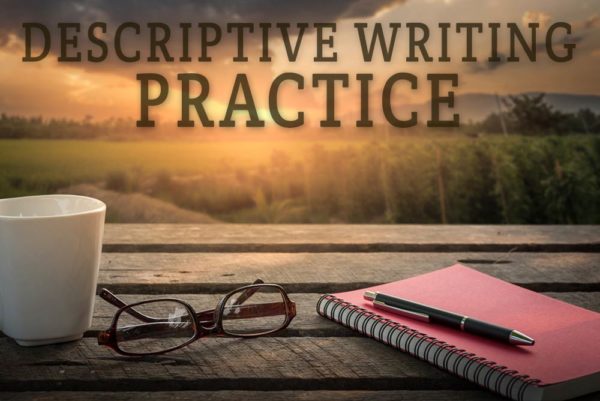
10 descriptive writing practices.
How to Practice Writing Description
Here are some descriptive writing activities that will inspire you while providing opportunities to practice writing description. If you don’t have much experience with descriptive writing, you may find that your first few attempts are flat and boring. If you can’t keep readers engaged, they’ll wander off. Work at crafting descriptions that are compelling and mesmerizing.
- Go to one of your favorite spots and write a description of the setting: it could be your bedroom, a favorite coffee shop, or a local park. Leave people, dialogue, and action out of it. Just focus on explaining what the space looks like.
- Who is your favorite character from the movies? Describe the character from head to toe. Show the reader not only what the character looks like, but also how the character acts. Do this without including action or dialogue. Remember: description only!
- Forty years ago we didn’t have cell phones or the internet. Now we have cell phones that can access the internet. Think of a device or gadget that we’ll have forty years from now and describe it.
- Since modern fiction is light on description, many young and new writers often fail to include details, even when the reader needs them. Go through one of your writing projects and make sure elements that readers may not be familiar with are adequately described.
- Sometimes in a narrative, a little description provides respite from all the action and dialogue. Make a list of things from a story you’re working on (gadgets, characters, settings, etc.), and for each one, write a short description of no more than a hundred words.
- As mentioned, Tolkien often spent pages describing a single landscape. Choose one of your favorite pieces of classic literature, find a long passage of description, and rewrite it. Try to cut the descriptive word count in half.
- When you read a book, use a highlighter to mark sentences and paragraphs that contain description. Don’t highlight every adjective and adverb. Look for longer passages that are dedicated to description.
- Write a description for a child. Choose something reasonably difficult, like the solar system. How do you describe it in such a way that a child understands how he or she fits into it?
- Most writers dream of someday writing a book. Describe your book cover.
- Write a one-page description of yourself.
If you have any descriptive writing practices to add to this list, feel free to share them in the comments.
Descriptive Writing
Does descriptive writing come easily to you, or do you struggle with it? Do you put much thought into how you write description? What types of descriptive writing have you tackled — descriptive essays, blocks of description within larger texts, or descriptions woven throughout a narrative? Share your tips for descriptive writing by leaving a comment, and keep writing!
Further Reading: Abolish the Adverbs , Making the Right Word Choices for Better Writing , and Writing Description in Fiction .

I find descriptions easier when first beginning a scene. Other ones I struggle with. Yes, intertwining them with dialogue does help a lot.
I have the opposite experience. I tend to dive right into action and dialogue when I first start a scene.
I came across this article at just the right time. I am just starting to write a short story. This will change the way I describe characters in my story.
Thank you for this. R.G. Ramsey
You’re welcome!
Great tips and how to practise and improve our descriptive writing skills. Thank you for sharing.
You’re welcome, Bella.
Hello Melissa
I have read many of your articles about different aspects of writing and have enjoyed all of them. What you said here, I agree with, with the exception of #7. That is one point that I dispute and don’t understand the reason why anyone would do this, though I’ve seen books that had things like that done to them.
To me, a book is something to be treasured, loved and taken care of. It deserves my respect because I’m sure the author poured their heart and soul into its creation. Marking it up that way is nothing short of defacing it. A book or story is a form of art, so should a person mark over a picture by Rembrandt or any other famous painter? You’re a very talented author, so why would you want someone to mark through the words you had spent considerable time and effort agonizing over, while searching for the best words to convey your thoughts?
If I want to remember some section or point the author is making, then I’ll take a pen and paper and record the page number and perhaps the first few words of that particular section. I’ve found that writing a note this way helps me remember it better. This is then placed inside the cover for future reference. If someone did what you’ve suggested to a book of mine, I’d be madder than a ‘wet hen’, and that person would certainly be told what I thought of them.
In any of the previous articles you’ve written, you’ve brought up some excellent points which I’ve tried to incorporate in my writing. Keep up the good work as I know your efforts have helped me, and I’m sure other authors as well.
Hi Stanley. Thanks so much for sharing your point of view. I appreciate and value it.
Marking up a book is a common practice, especially in academia. Putting notes in margins, underlining, highlighting, and tagging pages with bookmarks is standard. Personally, I mark up nonfiction paperbacks, but I never mark up fiction paperbacks or any hardcovers (not since college).
I completely respect your right to keep your books in pristine condition. And years ago, when I started college, I felt exactly the same way. I was horrified that people (instructors and professors!) would fill their books with ugly yellow highlighting and other markips. But I quickly realized that this was shortsighted.
Consider an old paperback that is worn and dog-eared. With one look, you know this book has been read many times and it’s probably loved. It’s like the Velveteen Rabbit of books. I see markups as the same — that someone was engaging with the book and trying to understand it on a deeper level, which is not disrespectful. It’s something to be celebrated.
Sometimes we place too much value on the book as a physical object rather than what’s inside. I appreciate a beautiful book as much as anyone but what really matters to me is the information or experience that it contains. I often read on a Kindle. Sometimes I listen to audio books. There is no physical book. The experience is not lessened.
I understand where you’re coming from. I used to feel the same way, but my mind was changed. I’m not trying to change yours, but I hope you’ll understand.
Trackbacks/Pingbacks
- 7 Sites You’ve Got to Check Out About Journaling! | The NoteBook Blogairy - […] Writing Forward: This eight-year-old website has TONS of great writerly information to share including a really wonderful piece about…
Submit a Comment Cancel reply
Your email address will not be published. Required fields are marked *
This site uses Akismet to reduce spam. Learn how your comment data is processed .

Subscribe and get The Writer’s Creed graphic e-booklet, plus a weekly digest with the latest articles on writing, as well as special offers and exclusive content.

Recent Posts
- Do You Need a Place to Write?
- 36 Tips for Writing Just About Anything
- A Handy Book for Poets – Poetry: Tools & Techniques: A Practical Guide to Writing Engaging Poetry
- Creative Writing Prompts for the Young at Heart
- From 101 Creative Writing Exercises: Cut-and-Paste Poetry
Write on, shine on!
Pin It on Pinterest
Writing effective descriptions
“Description begins in the writer’s imagination, but should finish in the reader’s.”
- Stephen King
Descriptive writing is a powerful tool that adds life and depth to your writing. Effective descriptions breathe life into your ideas and put the reader in the scene where those ideas live. If I want to write about my experience living in Japan, the best way I can relate that to another person is through description: the smell of the food, the sounds of the city, the beauty of the landscape.
Show don’t tell
This is one of the most important things to remember when writing descriptions. Don’t tell your reader what it was like, show them. Paint a picture to help them feel what you want them to feel and see what you want them to see.
Telling: I walked into the dark, creepy basement.
Showing: Stepping down into the basement, I reached out my hands to guide me through the dark, and I tried to ignore the mysterious smells creeping up my nose.
A basement is just a room. A room isn’t inherently creepy. It’s the details, the dark, the smells, the weird noises, that make it creepy. Telling the reader something is creepy doesn’t make them feel it. Using descriptive language to highlight the creepy details does.
Deliberate word choice
Does “big” mean the same thing as “massive”? Does “run” mean the same thing as “dash”? Not exactly. Deliberate word choice can go a long way towards making your descriptions more vivid (Bachman, Barnhart, & Krenzke, 1997, p. 53-54).
Plain word choice: Shannon ran and picked up her son just before a car drove by. Vivid word choice: Shannon dashed across the yard, grabbing her son away from the street just before a car raced by.
Less is more
The best descriptions are simple and to the point. You want to sprinkle your descriptions throughout your writing so that they complement the message you’re trying to convey, not bury it. Long, meandering descriptions derail the reader’s focus so they’re only thinking about what you’re describing, not what you’re writing about (Murdick, 2011, p. 115-116).
One of the best ways to learn any skill is to watch people who do it well. Reading is just as important to developing your writing skills as actually writing. Here are a few examples of effective use of descriptive language.
"The Snows of Kilimanjaro” Ernest Hemingway
Hemingway is famous for his straight-to-the-point writing style. Notice how, without much flowery language, he is able to paint a clear picture of the scene where the story is taking place. He does this by not describing everything. He describes the significant details, and he lets the reader fill in the blanks in their mind.
"’I Lost Literally Everything’: Historic Town Cleans Up After Catastrophic Flooding” Debbie Elliot
A news story like this is often just a collection of facts: number people displaced, hurt, or killed; the amount of property damage; inches of rain; etc. The problem with this is, when a hurricane hits the U.S., every news outlet in the country is going to be writing that exact story. Instead, Elliot zoomed in on the effects of the storm on individuals, and in doing so, she made the story about people instead of a storm.
"American Weirdness: Observations From an Expat” Rachel Donadio
This is a story completely about details. Instead of talking about the overarching cultural differences between France and the U.S., Donadio focuses on the little things. This is effective because it’s how people experience the world. Although this piece was written for a major news organization, it could easily be submitted for a school assignment about an experience you had while traveling.
Bachman, L., Barnhart, D., & Krenzke, L. (Eds.). (1997). Write for college. Wilmington, MA: Great Source Education Group.
Donadio, R. (2018, Sep. 18). American weirdness: Observations from an expat. The Atlantic. Retrieved from https://www.theatlantic.com/international/archive/2018/09/expat-america- europe/570580/
Elliot, D. (2018, Sep. 17). ‘I lost literally everything’: Historic town cleans up after catastrophic flooding. NPR. Retrieved from https://www.npr.org/2018/09/17/648671344/historic-n-c-town-deals-with- flooding-after-florence-blows-through
Hemingway, Ernest. (1938). The snows of Kilimanjaro. University of Virginia. Retrieved from http://xroads.virginia.edu/~drbr/heming.html’
King, Stephen. (2002). On writing: A memoir of the craft. New York, NY: Pocket Books. Murdick, W. (2011). A student guide to college composition (2nd ed.). Fremont, CA: Jane Publishing Company.
Contributor: Tony DeFilippo
Ink and Quills
Tips and tools to tell your story.

Writing 101: Creating Effective Description

So what tools do writers possess for bringing a setting to life through description? Let’s break down the different techniques.
Sensory Details
First, the senses. You’re probably familiar with them: sight, taste, smell, touch, and sound . Sight is the easiest to write and the one we think of first when setting up a scene, but you want to get into the habit of putting yourself into a scene and feeling it with all your senses.
What might your character be hearing ? Like the whistle of a kettle or a dripping faucet? What about physical sensations, like the warmth of the sun on his skin or the feel of damp sand between his toes?
Readers want to experience what your hero is experiencing. Going beyond sight grounds readers in the story and makes the setting feel rich with detail in their minds—and this in turn makes your fictional world feel more realistic.
Manipulating Mood through Word Choice
Now that we know how to make readers experience a story with their senses, how can we make them experience it emotionally using description? This writer’s magic trick is accomplished through the subtle power of word choice .
That’s right, friend, by being intentional about the words you choose you can make the reader feel whatever you want them too—without them even realizing it! Pretty neat, huh?
But you don’t want to choose any mood for your scene. Whenever you introduce a setting, your hero should have an emotional reaction to it, and this should influence the words you use to describe it. After all, readers want to experience what the hero is experiencing, right? This means his feelings about his surroundings too.
Does the hero find this place scary? Beautiful? Peaceful? Choose words that communicate what the hero is feeling—or even better, ask yourself, “What words would my hero use to describe this?”
Let’s take a look at the power of word choice with this quick example:
The castle loomed atop the cliff, its sharp spires slicing through the clouds. The iron bars of the gate had been wrenched open and now resembled the mangled ribs of a skeleton.
Notice how I didn’t say the castle was scary or creepy, though that’s likely the impression/feeling you got. Instead, I used words like loomed, sharp, slicing, wrenched, mangled, and the comparison to a skeleton’s ribs all help create a creepy, foreboding mood.
This is also an example of showing vs.telling . Instead of telling you the castle was creepy, I showed you through my word choice. Whenever you can, opt for showing over telling when appropriate .
“Wait, why are we talking about film?” you ask. “What does this have to do with writing?”
Allow me to explain.
A story plays out like a film in the mind, yes? Because of this, we can steal a few film tricks and apply them to our descriptions.
When you watch a movie and a new setting is introduced, it will usually be done with an extreme long shot that includes a large amount of the landscape such as a city or farm so the viewer can see where the action will take place. This is also called an establishing shot.
Then, the camera will narrow its focus to a normal long shot, which might show something like a house, kitchen, train station, etc. where the scene will take place.
Narrow the focus again to a full shot, and this allows the viewer to see more details of the character’s costumes and their surroundings.
Narrow the focus yet again to a mid-shot and we see the characters from the waist-up, allowing us to focus on their facial expressions and emotional reactions.
Narrow the focus one more time and we have a close-up of characters facial expressions or important objects.
So how does this translate into writing? We can use this technique to organize our descriptions and help them flow clearly in the reader’s mind. You do this by starting your description with a wide “establishing” shot, and then narrowing your focus.
For example:
The barn was tucked away in a meadow between two oaks, its tin roof rusted and black paint peeling. Sam shoved open the door and glanced over the rows of empty stalls and then upward at the vaulted loft filled with moldy hay. He kicked aside a rotting bucket and a mouse darted into the shadows. Wrinkling his nose, he crouched to examine the droplets of blood soaked into the earth among the spilled grain and mouse droppings.
Notice how I started with an establishing shot and kept narrowing the focus until we had a close-up description of the blood splatters. This not only helps the reader get their bearings in the scene, but it follows the natural way we experience a place—we notice the overall picture before we begin to zero-in on tiny details.
Specific Nouns
Getting as specific as possible with nouns in your description will make your world feel more realistic and create a much sharper image in the reader’s head.
Instead of “red flowers” say “poppies,” and instead of “fancy car” say “Lamborghini.”
Also, this requires you do your research. You should be able to specifically name things in your story no matter the culture or time period, such as the character’s clothing, the food they eat, the weapons used, etc.
If you’re writing a sci-fi story and your hero walks into a room full of “scientific equipment” not only is this a lousy mental image for the reader, but its lazy writing. What sort of equipment are they using? What is it called? What does it look like? It’s your job to find out.
Finally, one of the important parts of good description is balance, or knowing what to describe and when.
For example, the middle of an intense action scene is not a good time to unload a bunch of description. The reader simply won’t care and it will just get in the way. Save the description for the slower parts of your story where you are setting up a scene or introducing a new setting, character, important object, or what-have-you.
Also, you need to be discerning about what you choose to describe because you can’t (and shouldn’t!) describe everything. You’ll end up overwhelming the reader and weakening the description because they won’t be able to remember it all. So what should you focus on?
Here are 3 things to consider:
1) Choose the most important details, or the details that make the place interesting or different.
2) Choose specific details in order to set a certain mood.
3) Choose the details your character would notice. (For example, a hunter might admire a collection of rifles while a bookworm might admire a bookshelf in the same room. Different people notice different things).
But how much description is too much? This will vary based on your writing style and the type of story you’re telling.
For example, literary fiction can have longer passages of description because readers of that genre will expect and even enjoy it. But in a Young Adult action novel you’re going to want to go light on the description because your audience will have less patience.
Basically, a good rule of thumb is to tell the audience just enough to give them a clear picture and avoid any confusion. How much detail that entails, however, is up to you.
What’s your biggest challenge when writing description? What sorts of details bring a story to life for you? Let me know in the comments!
P.S. Behind on the Writing 101 series? Click to catch up! Part 1 (The Fundamentals of Story), Part 2 (Writing Term Glossary), Part 3 (Creating a Successful Hero & Villain), Part 4 (Unraveling Tension, Conflict, and Your Plot), Part 5 (Let’s Talk Dialogue), and Part 6 (Setting and Worldbuilding).
Ready for Part 8? Click here to learn about Tips and Resources for the Grammatically Challenged Novelist!

Like What You Read?
Get access to even more writing epicness.
- A private Facebook community for authors
- Exclusive first-access to posts before they're published
- Bonus weekly articles and resources delivered to your inbox
RELATED POSTS:

3 thoughts on “ Writing 101: Creating Effective Description ”
Great post, Kaitlin! I agree that it’s important to keep sensory details and mood in mind when describing something. The narrator / POV character will describe the same setting differently when she’s happy than when she’s angry or sad. And finding a balance between what to describe and what to leave out helps strengthen your writing, too.
It’s funny, because I’m actually drafting a post for my blog on description, from an editing standpoint. (Specifically, how to cut down on overdescription.) I think I’ll include a link to this post at the end of mine so readers can check it out if they want more information. 🙂
Yes, getting into the head of your POV character can definitely influence your descriptions in interesting ways! That sounds like a great post topic, I look forward to reading it! And I would be honored if you linked to my post ^.^ Thanks for stopping by, Sara!
This post has some amazing tips in it! I love using action words (like in your castle example) to really create mood in my writing. They can really bring how the character is feeling into it without saying ‘she didn’t like this place,’ etc. Sometimes I struggle though to bring in textural details, such as the feeling of an armchair, and scents as I tend to naturally focus on sight and sound. Thanks for the great post! 😀
Comments are closed.
- Skip to main content
- Skip to primary sidebar

Writing Tips Oasis - A website dedicated to helping writers to write and publish books.
10 Words that Describe an Abandoned House
By Ali Dixon

A house that is no longer inhabited can make a mysterious setting in a novel across so many genres. If you need some words that describe an abandoned house, use the following 10 as a source of inspiration.
1. Deserted
An area devoid of life ; a wild or forbidding place.
“The quiet house appeared completely deserted , though they still approached it with significant caution.”
“The deserted house stood in the middle of the empty plain. The only signs of life were the sounds of mice scuttling and scavenging for what the previous owners had left behind.”
How It Adds Description
The word deserted often implies an intention when it’s used in this context. The people who used to live in the house you’re describing may have left it on purpose, and you can use that to make your readers feel unnerved as they read about it.
2. Desolate
Empty of inhabitants or life ; joyless or sorrowful, usually because of some kind of separation; lacking comfort or hope.
“The floorboard of the desolate house creaked under his feet as he explored the rooms.”
“While the other houses on the street teemed with life, this one was cold and desolate. ”
When you use the word desolate to describe an abandoned house, this can help to make the house seem even more threatening. It can also give off a real sense of bleakness to your readers.
Reflecting or displaying discouragement or listlessness ; lacking in comfort or cheer; somber or gloomy.
“The inclement bad weather on the horizon made the house appear even more dreary .”
“The moth-eaten curtains fell still as the breeze stopped, the atmosphere in the room suddenly becoming dreary again.”
Describing something as dreary will instantly set a cold and gloomy mood. If you want to make sure that your readers understand that this house is something completely devoid of any life, this is a good word to use. The dreariness of the house could also represent a lack of motivation or hope in your characters.
4. Derelict
Abandoned by an occupant ; voluntarily abandoned.
“The house used to be owned by a wealthy woman who had abandoned it some years ago. Now it stood empty and derelict .”
“The derelict house had not been maintained, and she worried that it would fall apart with her inside.”
The word derelict implies that something has been abandoned purposefully, which can help add an ominous tone to your description. Perhaps something inside it was dangerous that forced the previous occupant to leave it behind which your character must now discover.
Not having anything in it; uninhabited or unoccupied.
“He could imagine the house in its heyday with beautiful decorations and plenty of visitors instead of the empty shell he saw before him now.”
“The owner had taken all of her things with her, leaving the house now completely empty .”
The house you’re describing may literally have nothing inside it, which makes this word a great one to use to describe it. You can also use it to make it seem like it’s empty, and then have something surprise your characters and readers later.
6. Untended
Not managed or watched over .
“The plants in the house’s untended garden had been left to grow wild, and now vines completely covered the south side of the house.”
“The house was large enough to warrant cleaning staff, but since it had been abandoned it had been left completely untended , and she doubted it would ever look the way it once had again.”
Describing the abandoned house you have in your story as untended can help readers feel as though there is almost something wild about it now that no one is caring for it.
Not well-kept ; lacking in quality; faded from wear.
“The house looked shabby —it was clear that no one had lived in it in a long time.”
“The once comfortable and beautiful furniture had faded and become shabby with age and time.”
Shabby is a good word to use to describe the way that the abandoned house in your story looks. By describing it using this word, you’ll give readers the sense that it’s not a good-looking house or that it’s been neglected for some time.
8. Forgotten
Disregarded ; something that people have lost remembrance for; overlooked, sometimes intentionally.
“Whoever had been left in charge of caring for the house hadn’t done so in some time, and now the house appeared to be completely forgotten .”
“To find the old journal, they would have to sift through the abandoned, forgotten house at the end of the street.”
Using the word forgotten tells readers that not only is this house abandoned, but the person or people meant to care for it have disregarded its existence entirely. You can imply a much more somber mood by using this word.
9. Forsaken
To forsake something is to turn away from it entirely ; forgotten.
“They were quick to help the man in need, but they left the house itself forsaken .”
“The house had been forsaken long ago, and she wasn’t eager to investigate it now to see why.”
If you describe the abandoned house in your story as forsaken, your readers will immediately get the sense that this isn’t a house that’s simply been left behind. It’s something that was intentionally abandoned or turned away from for whatever reason.
10. Neglected
Not cared for or provided with the necessary attention .
“The house had obviously been neglected for some time, and it was now overrun with small animals and dust.”
“Even while they were living there, the previous owners had left the house neglected , and now that it was abandoned it looked worse than ever.”
The word neglect implies an intentional act to leave something or to not care for it. If you use this word to describe the house in your story, you can also use it as a way to symbolize that the character looking at it may also feel neglected in some way.
Describing Places and Buildings
You will hear a man talking to a travel agent about a city he finally decides to visit. Read the table then listen to the tape and tick the information mentioned. Finally, use the table to talk about the city described.
reason for visiting: sights:
Athens Dublin [] Edinburgh [] Greece 0 Ireland 0 Scotland [D holiday Q business Q
castle Q Royal Palace Q St Patrick's Cathedral Q
free-time activities: pubs Q museums Q theatres [[] cinemas Q cafés Q parks Q funfairs Q bistros Q
recommendation: highly recommended Q expensive Q boring Q
A composition describing a place/building should consist of:
a) an introduction giving brief information about the name and location of the place /building and stating the reason for choosing to write about it (e.g. What It is famous for, what makes It so special, etc.)
b) a main body giving both general and specific details about the place/building usually moving from the general features to specific ones, i) when you describe a place you should give the overall impression by referring to landscape, buildings, landmarks, etc, and particular details (sights to see, places to go, things to do) ii) when you describe a building you should write about its surroundings (e.g. situated In Oxford Street...), then give a detailed description of its exterior and interior; and,
c) a conclusion in which you express your feelings or opinion concerning the subject or give a recommendation.
• You may also be asked to explain why a particular place is important to you, popular, etc. Note that the number and length of paragraphs varies depending on the topic.
• Descriptions of places/buildings may be included in several other types of writing tasks, such as stories, assessment reports, articles, brochures, letters and magazine articles.
Points to Consider
• Descriptions of places/buildings may include: factual information such as age, size, colour, materials, etc (e.g. The temple, with 10-metre tall marble columns, was built In 800 BC.), details relating to the senses (sight, hearing, smell, touch, taste) to suggest mood and atmosphere (e.g. Visitors' footsteps on the worn stone floors echo through the cool, dark corridors, disturbing the tranquil silence.), opinions/impressions of the place or building (e.g. Tourists are fascinated by its air of mystery.)
• Each aspect of the description should be presented in a separate paragraph beginning with a clear topic sentence.
• The use of descriptive vocabulary (e.g. exquisite, exclusive, towering, etc), a variety of linking words and structures as well as narrative techniques will make your writing more interesting.
• Present tenses are normally used when describing a place for a tourist brochure or a magazine article. Past tenses are normally used when describing a visit to a place/building. First and second conditionals (will/would) can be used when you describe your ideal city/house, etc. Note that when we give factual information about a place or building this is normally given using Present tenses, (e.g. I flew to Madrid last Monday. Madrid Is situated in the central point of the Iberian peninsula with a population of about 3,000,000.)

introduction
Paragraph 1
name I location I population of the place, reason for choosing the place
Paragraphs 2 - 3
general features and particular details (place: surroundings, sights, facilities, free-time activities
building: surroundings, detailed description of exterior/interior) Paragraphs 4-5 explanation and example/justification
Final Paragraph
comments/feelings and/ or a recommendation
2 Read the model below and fill in the plan on the right. Then, look at the highlighted adjective-noun combinations, close your books and try to remember as many of them as possible.
Describe o large, busy city
Built around a small peninsula in the south east of China, Hong Kong, now one of the most densely populated places on earth, is a city of extreme contrasts, where East meets West, and the latest technology is equally as important as ancient customs are.
The streets of Hong Kong are a frenzy of activity and deafening noise. The roads are congested with vehicles, from sparkling limousines to dusty rickshaws, while countless hordes of people stream past on the pavements, and in the crowded narrow alleyways, the senses of the pedestrian are bombarded with a bewildering variety of exotic sights and smells. In contrast, not far from the chaotic, cramped city centre lie parks with cool streams, shrines and chirping birds. Meanwhile, tranquil mountains form a breathtaking backdrop to the towering skyscrapers of steel and concrete packed closely around the harbour, where huge modern ships float alongside little Chinese junks..
Below the bright neon lights, garishly advertising every brand name conceivable, visitors will find an endless variety of shops and restaurants competing for space on Hong Kong's manic streets. You can buy anything here, ranging from state-of-the-art computer technology to hand-made silk suits. There are also fish and bird markets all over the city, where heaps of gleaming silver fish can be found displayed next to brilliantly-coloured squawking parrots. Tourists and locals alike flock to the Jade Market, hidden on a side street, with its intricately-carved pieces depicting Chinese icons, Buddhas and dragons made of smooth green stone. For food, Hong Kong Is second to none, as it offers a wide choice of dishes in all sorts of eating establishments. The city's nightlife, like its shops and restaurants, caters for all tastes, whether you are searching for the opportunity to serenade your loved one in a karaoke bar or are simply after a beer and a bit of dancing.
Perhaps the strangest thing about Hong Kong is the way ail ofits" dramatically contrasting features co-exist so harmoniously. However, unless you witness it for yourself, you will never know what a pleasant atmosphere this creates. So. for an unforg unique experiett^try Hong Koi* 3tfou»won't regret it.

• Introduction
location, population, reason
• Main Body general features
particular details
//f Location Verbs and / Prepositions
• There are a number of verbs used to describe the location and/or surroundings of a place. These may explain position (e.g. the old house is situated next to/is surrounded by..)] they may also give some suggestion of movement (e.g. the road leads up to/winds past...) and/or action (e.g. the statue towers above/stands at the top of...).
0 These verbs are naturally used with prepositions and prepositional/adverbial phrases (e.g. leads up to -winds past - stands at the top of, etc).
Built around a small peninsula in the south east of China, Hong Kong, now one of the most densely populated places on earth, is a city of extreme contrasts. where East meets West, and the latest technology is equally as important as ancient customs are.
The streets of Hong Kong are a frenzy of activity and deafening noise. The roads are congested with vehicles, from sparkling limousines to dusty rickshaws. while countless hordes of people stream past on the pavements, and in the crowded narrow alleyways, the senses of the pedestrian are bombarded with a bewildering variety of exotic sights and smells. In contrast, not far from the chaotic, cramped city centre lie parks with cool streams, shrines and chirping birds. Meanwhile, tranquil mountains form a breathtaking backdrop to the towering skyscrapers of steel and concrete packed closely around the harbour, where huge modem ships float alongside little Chinese junks..
Below the bright neon lights, garishly advertising every brand name conceivable. visitors will find an endless variety of shops and restaurants competing for space on Hong Kong's manic streets. You can buy anything here, ranging from state-of-the-art computer technology to hand-made silk suits. There are also fish and bird markets all over the city, where heaps of gleaming silver fish can be found displayed next to brilliantly-coloured squawking parrots. Tourists and locals alike flock to the Jade Market, hidden on a side street, with its intricately-carved pieces depicting Chinese icons, Buddhas and dragons made of smooth green stone. For food. Hong Kong is second to none, as it offers a wide choice of dishes in all sorts of eating establishments. The city's nightlife, like its shops and restaurants, caters for all tastes, whether you are searching for the opportunity to serenade your loved one in a karaoke bar or are simply after a beer and a bit of dancing.
Perhaps the strangest thing about Hong Kong is the way all of its dramatically contrasting features co-exist so harmoniously. However, unless you witness it for yourself, you will never know what a pleasant atmosphere this creates. So, for an unfc unique experience, try Hong Kong - .you. won't regret it.

Location Verbs and /' Prepositions
• There are a number of verbs used to describe the location and/or surroundings of a place. These may explain position (e.g. the old house te
they may also give some suggestion of movement (e.g. the road leads up to/winds past...) and/or action (e.g. the statue tower? above/stands at the top of...).
These verbs are naturally used with prepositions and prepositional/adverbial phrases (e.g. leads up to -winds past - stands at the top of, etc).
14).....-.......-
rurthcr 15) .............the street, 1« R ^¡c.
quaint two-storey building with ^ —s bu.lt ^ ^
The street disappears 17)..............
rises 18)......-......the whole scene.

3 Fill in the gaps with words from the list below Use the words only once. stretch out, is set in, winds through, nestles at, is perched on, curi es around, sprawl out, is located in, slopes down to -
1 The small house, which.................................................the centre of town,
is packed with antiques.
2 The narrow country lane................................................the wooded valley.
3 The steep hillside.....................................................................the seashore.
4 The hotel....................................................the towering Welsh mountains.
5 The river..............................................................the base of the mountain.
6 The plains.........................................................................in every direction.
7 The cabin................................precariously.................................aclifftop.
8 The suburbs.................................................................into the countryside.
9 A tiny village...............................................the foot of the high mountain.
4 Read the following description. Fill in each of the gaps with a suitable preposition or adverb and circle each of the 'location' verbs.
ZiZStt^«*'*»"*"*-......
*» «—' 5) -.......S,ree,.he bottom of .he steps is a shop,
S^rJ^U^ building tha, stands S, __
,h;:r. SSi« « -a.........--
11»....................%u25A0 thefirst floor hangs
imposing building. A small balcony 13) -------------
Continue reading here: Approaching The Central Square You Can Hear The Hum Of Laughter And Voices Along With The Clinking F Glasses
Was this article helpful?
Recommended Programs

Mastering Book Publishing

The 24 Hour Book System

Kindle Money Mastery
Related Posts
- Describe - Composition Writing
- UNIT Narratives - Composition Writing
- Linking Cause And Effect - Composition Writing
- Describing - Academic Writing
- UNIT Describing festivalseventsceremonies
- The Parallel Style - Writing Process
Readers' Questions
How to describe greatness in buildings?
Greatness in buildings can be described through various characteristics, including: Architectural grandeur: Great buildings often feature impressive and grand architectural designs that command attention and awe. Innovation: Great buildings push the boundaries of design and construction, incorporating innovative technologies and techniques that set them apart from others. Scale: Great buildings are often large in scale, with impressive dimensions that create a sense of awe and wonder. Cultural significance: Great buildings can also be defined by their cultural significance, representing important landmarks or symbols of a community or society. Historical importance: Great buildings may also have historical importance, serving as important markers of events or periods in history. Impact on the environment: Great buildings are often built with careful consideration for their environmental impact, incorporating sustainable design practices and materials. Functionality: Great buildings are not only visually stunning, but also highly functional and well-designed, serving their intended purpose effectively and efficiently.
How to describe buildings in creative writing?
Describing buildings in creative writing requires attention to detail, the use of sensory language, and the ability to evoke emotions in the reader. Here are some tips to help you effectively describe buildings: Observe and note details: Take time to closely observe the building you want to describe. Pay attention to its architecture, materials, size, color, and any unique features. Note down specific details that stand out to you. Use vivid imagery and sensory language: Bring the building to life by using strong descriptive language that engages the reader's senses. Describe how the building looks, sounds, feels, smells, and even tastes, if applicable. For example, you could mention the crumbly texture of weathered bricks or the crisp sound of footsteps on a marble floor. Appeal to emotions: Buildings can evoke different emotions based on their purpose, history, or the feelings they inspire. Consider the atmosphere the building creates or the feelings it elicits in people who interact with it. Is it imposing, inviting, or mysterious? Does it arouse curiosity or nostalgia? Use descriptive words and metaphors that convey these emotions. Use metaphor and personification: Comparing the building to something else can help create a vivid and unique image in the reader's mind. Metaphors and similes can be powerful tools for description. For example, you could compare a towering skyscraper to a monolithic giant that scrapes the sky. Incorporate architectural language: Knowledge of architectural terminology can enhance your descriptions. For instance, use terms such as columns, arches, spires, or cornices to provide specific details about the building's design or style. However, be careful not to overwhelm your reader with excessive jargon. Focus on significant elements: Instead of describing every part of the building, concentrate on the details that are most relevant to the story or scene you are writing. Highlight architectural highlights, symbols, or aspects that contribute to the building's character or function. Capture the passage of time: Consider how the building may have changed over time or how it ages. Does it bear the marks of history or show signs of decay? Describing signs of wear can add depth and realism to your descriptions. Remember, effective description in creative writing paints a picture in the reader's mind and transports them into the world you are creating. Experiment with different techniques to capture the essence of a building while staying true to the tone and style of your writing.
How to describe a building with appropriate syntax?
When describing a building using appropriate syntax, it is important to structure your sentences and phrases in a coherent and grammatically correct manner. Here is an example of how you can describe a building with appropriate syntax: The magnificent building stood tall against the skyline, its sleek glass façade reflecting the gleaming sunlight. With its imposing height and modern architecture, it exuded an air of grandeur and sophistication. The entrance, adorned with ornate metalwork and carved stone columns, beckoned visitors inside. Beyond the revolving doors, a spacious lobby greeted guests, featuring a cascading chandelier that bathed the area in a warm, soft glow. The interior boasted a harmonious blend of contemporary design and classic elements, with high ceilings, elegant light fixtures, and tasteful artwork adorning the walls. As you moved through the building, each floor unveiled a myriad of meticulously crafted offices, cozy meeting rooms, and state-of-the-art facilities equipped with the latest technology. The large windows offered breathtaking views of the surrounding cityscape, inviting ample natural light to fill the workspaces. Every detail in this building showcased a commitment to both aesthetic appeal and functionality, creating an inspiring and productive environment for all who enter.
How to write a composition about a city?
Writing a composition about a city requires thorough research, observation, and a creative approach. Here is a step-by-step guide to help you write an engaging and descriptive composition about a city: Choose a city: Decide on the city you would like to write about. Make sure it is a city you are familiar with or have enough information about. Conduct research: Gather information about the city from various sources, such as travel websites, books, documentaries, or official city websites. Focus on key elements like architecture, history, culture, landmarks, local cuisine, and its unique characteristics. Take note of interesting stories or facts that can make your composition more captivating. Make an outline: Organize your thoughts and create a structure for your composition. Divide it into sections to cover different aspects related to the city. A possible outline might include an introduction, history and background, sights and landmarks, local culture and traditions, cuisine, and a conclusion. Craft a captivating introduction: Begin your composition by introducing the city in an engaging way. You can start with a fascinating fact or an interesting anecdote that will grab the reader's attention. Provide some background information about the city and its significance. Describe the city's history and background: Give an overview of the city's history, origins, and how it has evolved over time. Mention any significant events or historical figures associated with the city. Explain how the city's past has shaped its present. Explore the sights and landmarks: Highlight the unique sights, landmarks, and attractions of the city. Describe them in detail, including their architecture, historical significance, and the experiences they offer. Use descriptive language to help paint a vivid picture in the reader's mind. Discuss local culture and traditions: Explore the local culture, traditions, and customs that make the city unique. Talk about festivals, art, music, dance, and other cultural activities that represent the city's identity. Include any local legends, folklore, or myths that add to the city's charm. Describe local cuisine: Discuss the city's culinary scene and its signature dishes. Mention any renowned restaurants or street food stalls that offer a taste of the city's flavors. Describe the ingredients, cooking methods, and any cultural significance attached to the local cuisine. Provide personal experiences or anecdotes: If you have visited the city, share your personal experiences and impressions. Include any interesting encounters or stories that showcase the city's character. This will add a personal touch to your composition. Conclude with a reflection: Summarize the main points discussed in your composition and reflect on the overall impression the city has left on you. Express your personal feelings, whether you find the city inspiring, welcoming, or captivating. Tie everything together to leave a lasting impression on the reader. Edit and revise: After completing your composition, read through it carefully, checking for any grammatical or structural errors. Ensure your sentences flow smoothly, and the composition is coherent. Make any necessary revisions to improve its clarity and readability. By following these steps, you can create an engaging and comprehensive composition about a city that will captivate your readers and leave them with a vivid understanding of its distinctiveness.
Which technique is used for describing buildings, places or locations?
One technique used for describing buildings, places, or locations is sensory description. This involves using descriptive language to engage the reader's senses and create a vivid image of the specific setting. This technique focuses on capturing the sights, sounds, smells, textures, and even tastes associated with the location. By appealing to multiple senses, sensory description provides a more immersive and detailed portrayal of the building, place, or location.
When you describe a building in a trip past tense?
When I described the building during my trip in the past tense, I would say: The building was magnificent and grand. Its architecture was unique and captivating. The walls were adorned with intricate carvings, adding to its charm. The windows were grand and allowed ample sunlight to filter through. It had a beautiful courtyard with lush greenery, providing a serene and peaceful atmosphere. The entrance was adorned with a grand door, which opened to reveal a magnificent interior. The building seemed to have an air of history and stories waiting to be discovered. Overall, it was a remarkable sight that left a lasting impression on me.
How to explain exterior of a place?
When explaining the exterior of a place, you can provide a detailed description focusing on different aspects such as architecture, design, surroundings, and overall appearance. Here is a step-by-step guide to help you explain the exterior of a place effectively: Keep the location in mind: Start by briefly mentioning the general location of the place, whether it is in a city, a suburban area, or a rural setting. This will help the listener or reader form an initial picture in their minds. Mention the architectural style: Describe the architectural style of the building or place. Is it Victorian, modern, classical, or something else? Point out any unique or distinctive features that stand out. For example, you could mention the use of columns, arches, or specific decorative elements. Discuss size and scale: Provide some information on the size and scale of the place. Is it large or small, towering or compact? This will help give an idea of the building's prominence in its surroundings. Observe the materials: Comment on the materials used in constructing the exterior. Are there brick walls, wooden panels, glass facades, or combinations of different materials? Mentioning the materials helps create a visual image and gives an understanding of the overall texture and appearance. Highlight colors and paintwork: Describe the color scheme and paintwork used on the exterior. Are there bright and vibrant colors or more muted tones? Is there any decorative painting or artwork on the walls? Colors can greatly contribute to the impression created by the exterior. Emphasize landscaping and surroundings: Take note of the surrounding environment. Are there gardens, lawns, or trees surrounding the place? Are there any pathways, driveways, or parking areas? Describe how these elements enhance or complement the overall appearance. Add detail about entrance and façade: Describe the entrance area and the façade. Are there imposing doors, grand staircases, or eye-catching windows? Are there any decorative elements or architectural details that catch your attention? This information will help create a complete picture of the exterior. Mention any distinguishing features: Point out any unique or distinguishing features that make the place stand out. It could be an iconic sign, a historic marker, or a statue. These features can add character and contribute to the overall perception of the place. Set the mood or ambiance: Summarize the overall atmosphere or vibe conveyed by the exterior. For instance, if it is a quaint café, you might describe it as charming and inviting. If it is a commercial building, you might describe it as sleek and professional. Remember to use descriptive language, vivid imagery, and sensory details to enhance the understanding and visualization of the exterior of the place you are explaining.
How do we describe a place like an airport or library?
To describe a place like an airport or library, you can focus on several aspects such as its physical attributes, atmosphere, activities, and amenities. Consider the following suggestions: Physical attributes: - Begin by describing the exterior of the building, its size, design, and architectural style. - Discuss the layout and organization of the different sections or areas within the place. - Mention any distinctive features, such as large windows, high ceilings, or unique artwork. Atmosphere: - Comment on the overall atmosphere of the place. Is it busy, calm, or somewhere in between? - Describe the sounds and smells that are characteristic of the location. For example, in an airport, you may mention the hum of conversations, announcements, or the scent of fresh coffee. Activities: - Explain the primary activities that take place at the location. In an airport, people primarily engage in check-ins, security checks, waiting, or boarding. In a library, individuals may be reading, studying, or accessing resources. Amenities and services: - Discuss the amenities available in the place. In an airport, mention features such as food courts, lounges, duty-free shops, or charging stations. In a library, you could highlight facilities like study rooms, computer stations, or specialized collections. People and interactions: - Observe and describe the people who frequent the location. Are they tourists, families, students, or business professionals? How do they interact with each other? - Reflect on the social dynamics within the place. Are people generally engaged in conversations, focused on individual tasks, or interacting with staff members? Unique details: - Highlight any unique or interesting details that make the location stand out. For example, in an airport, you might mention the presence of art installations or the sight of planes taking off and landing. In a library, you could note the peacefulness or the diversity of books available. Remember to adapt and tailor your description based on the specific location you are describing, as airports and libraries can vary significantly in size, style, and amenities.
How to describe a bulidong?
A building can be described using several key aspects: Architecture and design: Start by mentioning the overall architectural style of the building, such as contemporary, modern, or traditional. Describe any distinctive features like arches, columns, or domes. Mention the building's shape, height, and proportionality. Example: The building is a stunning example of modern architecture with sleek lines and a minimalist design. Its sleek glass façade gives it a futuristic feel, while the asymmetrical shape adds an element of interest. Materials and colors: Describe the materials used in the building's construction and their colors. Mention any combinations of materials or notable details, such as a brick façade, glass panels, or metal accents. Example: The building's exterior is adorned with a combination of polished concrete and steel, creating a unique blend of industrial and contemporary aesthetics. The concrete is a light grey shade, perfectly complementing the steel's metallic silver finish. Surroundings and location: Discuss the building's location and its relationship with its surroundings. Mention any unique features of the setting, such as parks, water bodies, or urban landscapes. Example: Sitting at the heart of the vibrant city center, the building is surrounded by a bustling skyline of other towering structures. It overlooks a picturesque waterfront and is conveniently located near bustling shopping districts and cultural landmarks. Function and purpose: Describe the building's function and purpose. Mention if it's a residential, commercial, or public building and highlight any unique amenities or facilities. Example: The building serves as a modern office space, housing various businesses and offering state-of-the-art amenities like a rooftop garden, conference rooms, and a fitness center. The ground floor also hosts a trendy café, providing a gathering place for workers and visitors alike. Interior features: If applicable, mention any notable interior features, such as impressive lobbies, open-concept layouts, or high ceilings. Discuss the use of natural light, spatial organization, or innovative design elements. Example: Upon entering the building, visitors are greeted by a grand lobby adorned with marble floors, cascading chandeliers, and a towering glass atrium that floods the space with natural light. The interior spaces are designed with an open-concept layout, allowing for uninterrupted sightlines and a sense of spaciousness. Remember to use descriptive adjectives and sensory details to bring your description to life. And don't forget to convey your personal impressions or emotions about the building, if applicable.
What tense should i write in when i talk about the landscape of a place i visisted?
When describing the landscape of a place you visited, you can use the past tense. This is because you are referring to an experience or observation that occurred in the past. Consider using vivid descriptive language to paint a picture of the scenery and atmosphere you encountered during your visit.
How to describe a building descriptive writn?
When it comes to describing a building in a descriptive piece of writing, you want to engage the reader's senses and paint a vivid picture in their mind. Here are some steps to follow: Observe the building carefully: Take note of its size, shape, and architectural style. Look at the materials used in construction, such as brick, stone, or glass. Start with an engaging opening sentence: Capture the reader's attention right from the beginning. For example, "Standing tall amidst the bustling city streets, the majestic Victorian-era building imposes its grandeur on all who pass by." Focus on the exterior: Describe the general appearance of the building. Use appropriate adjectives to convey its character. Is it modern, elegant, or imposing? Mention unique architectural features, like arched windows, ornate carvings, or a rooftop garden. Describe the surroundings: Explore the building's environment and how it interacts with it. Is it surrounded by a neatly manicured garden, or is it squeezed between other towering structures? How does the setting enhance or detract from the building's appeal? Engage the senses: Appeal to the reader's senses by describing how the building looks, sounds, smells, and feels. For example, you might mention the gleam of sunlight reflecting off its glass windows, the creaking of the wooden doors, the scent of freshly cut grass, or the coolness of the stone walls. Consider the historical and cultural context: If the building has a significant history or cultural importance, mention it and explain its significance. This will provide deeper meaning and context to your description. Discuss interior details: Describe the interior of the building, focusing on notable features or highlights. Are there grand chandeliers, winding staircases, or intricate murals? What emotions or atmosphere does the interior evoke? Conclude with a summary: Provide a final impression by summarizing the building's overall impact. Revisit its defining characteristics and leave the reader with a memorable image. For example, "As I reluctantly walked away, I couldn't help but admire the building's timeless beauty and the stories it held within its walls." Remember, the goal is to transport the reader to the location and allow them to experience the building through your words. Paint a vivid picture with your descriptions, and allow your passion for architecture to shine through.
How to talk about a building's structure?
When talking about a building's structure, you can follow these steps: Start by giving a brief introduction: Begin the conversation or presentation by providing some general information about the building, such as its purpose, location, or historical significance. Discuss the building materials: Talk about the materials used in constructing the building, including the type of foundation, walls, floors, and roof. Mention if the building is made of wood, concrete, steel, glass, or a combination of these materials. Highlight the architectural style: Describe the architectural style of the building, whether it is classical, modern, gothic, contemporary, etc. Explain any unique features or elements that contribute to its overall design. Mention the structural elements: Discuss the primary structural components of the building, such as columns, beams, load-bearing walls, or trusses. Explain how these elements support the weight of the building and distribute the load evenly. Explain the layout and floor plan: Describe the layout of the building, including the arrangement of rooms, hallways, staircases, and any specific architectural features. Discuss how the structure is organized to serve its intended purpose effectively. Talk about the building's stability and safety: Address the structural integrity of the building, highlighting the measures taken to ensure its stability and safety. Mention any earthquake-resistant features, fire suppression systems, or other security measures incorporated into the structure. Discuss any innovative or sustainable design aspects: If applicable, mention any environmentally friendly or energy-efficient design elements incorporated into the building's structure, such as green roofs, solar panels, or rainwater harvesting systems. Include any historical or cultural significance: If the building has historical or cultural importance, explain its significance and how the structure reflects the time period or cultural context in which it was built. Invite questions or encourage further exploration: Conclude your discussion by inviting questions from the audience or suggesting further exploration of the building's structure through books, articles, or online resources. Remember to adapt your conversation or presentation based on the level of technical knowledge of your audience. Use appropriate terminology and provide visual aids, such as diagrams or photographs, if possible, to make your discussion more engaging and understandable.
What is the main reason that so many buildings described in �t?
okyo yakuyoke building� The main reason why so many buildings are described in Tokyo Yakuyoke Building is due to the fact that Tokyo is one of the most densely populated cities in the world. Tokyo is well known for its modern architecture and the building designs are notable for their height, distinctiveness and creative use of space. As a result, the Tokyo Yakuyoke Building is an invaluable source of information for architects, urban planners and developers looking to understand the unique characteristics of Tokyo's built environment.
How to roght description of a place where something iwll be built?
This is an ideal location for construction, with easy access to main roads, ample nearby parking, and a location that can accommodate the necessary construction materials. The land is flat, allowing for easy construction of the desired structure. The site is free of any potential environmental hazards, and the surrounding area is supportive of the construction project. This is a great location to build the desired project.
What is the location of building in the populated place?
The exact location of a building in a populated place will depend on the specific area, since buildings are typically located in different places within a populated area. For example, a building in a city may be located in the downtown area, while a building in a rural area may be located in a more remote location.
How to describe a location of a building in essay?
This essay describes the location of a building in terms of its geographical position as well as its relationship to the surrounding area. The building in question stands at the corner of Main Street and Elm Road, near the center of the city. It is close to several shops and restaurants, making it an ideal spot for business meetings and social gatherings. The area is well lit and well maintained, with plenty of greenery to add to the ambiance. There is a parking lot directly next to the building, and public transportation is easily accessed nearby. The building is surrounded by commercial and residential areas, with plenty of trees and greenery in between. To the east is a small park, perfect for taking a break during work or leisurely strolls. To the west, there are numerous restaurants and boutiques to enjoy. The shopping district is just a few blocks away as well, offering a variety of options for customers. Overall, the building is located in a prime spot, with plenty of amenities and attractions nearby. It is the perfect place to conduct business, meet up with friends, or simply take in the city.
How to describe a building in writing description?
This grand old building stands tall in the bustling city center. With its ornate architecture and classic stonework, it has a timeless beauty that captures the attention of passersby. The tall ceilings, expansive windows, and intricate details make it a marvel to behold, even after so many years of wear and tear. Its doors are adorned with intricate carvings and embossings of symbols from another era, and the large pillars that line the entrance add an extra layer of grandeur to the facade. Inside, there is a grand hallway with marble floors, wide staircases, and beautiful design elements throughout. The walls are adorned with artworks that tell the long history of this building and the people who have called it home for so many years. This amazing building has a story to tell and is sure to capture the hearts of all who enter.
What does it mean when we talk about the composition of buildings?
When we talk about the composition of buildings, we are referring to the materials and methods used in the construction of the building, as well as the way the building is designed and laid out. This includes things like the type of foundation, walls, doors, windows, floors, ceilings, roof, and other elements that make up the building.
How to describe books?
Books can be described by their genre, setting, characters, plot, style, tone, and main themes. Some other descriptors include the author's writing style, structure, level of complexity, and the illustrations or other artwork used.
How to describe a house in writing?
This house is an impressive two-story brick construction with a modern, contemporary design. The front facade features a wide porch with white columns and plenty of windows with cream-colored trim. The main entrance is situated on the side of the building with a long, sweeping driveway and a large garage. Inside, the floor plan is spacious and open. High ceilings soar above a combination living and dining room, and the kitchen features stainless-steel appliances and plenty of counter space. A large fireplace is the centerpiece of a cozy family room, while the master suite upstairs has its own private balcony. Out back, a large patio overlooks the manicured lawn and garden.
How to describe a building in writing?
This building is a tall, stately structure made of red brick and white stone. It has soaring columns that reach up to the sky and a grand entrance complete with polished wood and marble. The windows are large, allowing plenty of natural light to flood into the interior. Inside, the walls are adorned with art and the floors are vacuumed and waxed to a shine. The overall design is one of elegance and sophistication, and it gives off an aura of timelessness and grandeur.
How to write a composition about a place?
Writing a composition about a place can be a creative and engaging task. Whether you are describing a favorite vacation spot, a historic landmark, or a hometown, here are some steps to guide you in writing an effective and vivid composition about a place: Choose a place: Select a place that holds significance for you, such as somewhere you have visited, lived in, or feel a strong connection with. It could be a specific city, neighborhood, beach, mountain, or any unique location. Brainstorm and research: Gather your thoughts about the place by brainstorming the key elements or characteristics that come to mind. Also, conduct research to learn more about the geography, history, culture, people, and landmarks associated with the place. This will help you add depth and authenticity to your composition. Create an outline: Organize your ideas by creating an outline. This will give your composition a clear structure and prevent it from becoming disorganized. Consider dividing your composition into sections, such as introduction, description of landmarks or features, personal experiences, and conclusion. Introduction: Begin your composition with a captivating introduction that sets the tone for your piece. Grab the reader's attention with a catchy sentence or an intriguing fact about the place. Provide brief background information and state the purpose or significance of the place in your life or the lives of others. Description: In this section, vividly describe the place using sensory details. Use descriptive language to paint a picture in the reader's mind. Describe the physical features, such as the landscape, architecture, weather, or natural elements. Include sensory experiences like the sounds, smells, tastes, and textures associated with the place. Personal experiences: Share your personal experiences and connections with the place. Discuss your memories, emotions, and what makes the place special to you. You can narrate specific incidents, interactions with locals, or cultural traditions you have encountered. Be honest, reflective, and engage the reader by making them feel connected to your experiences. Historical or cultural significance: If applicable, provide historical or cultural insights about the place. Explain any relevant events, developments, or cultural traditions associated with the location. This adds depth and context to your composition. Conclusion: Wrap up your composition by summarizing the main points and emphasizing the significance of the place. Reflect on its impact on you or others and convey a sense of closure. End with a memorable statement or leave the reader with a thought-provoking question. Revise and edit: After completing your composition, revise it for clarity, coherence, and grammar. Ensure that your ideas flow smoothly and your writing is error-free. Additionally, check if you are effectively conveying the essence of the place and its significance. Remember, a well-written composition about a place should transport the reader there and make them experience it through your words.
How to describe buildings in writing?
Buildings can be described using adjectives such as tall, grand, imposing, ornate, bustling, regal, and majestic. Other words to consider include stately, luxurious, magnificent, and imposing. One might also focus on the architectural style of the building, pointing out details such as columns, arches, windows, turrets, balconies, and porticos. Describe the colors, textures, and materials used in the structure, as well as any particular art or sculpture that the building might feature. Details such as landscaping, lighting, and the surrounding area can all be used to create a vivid description of a building.
Is these a special writing on the building to identify the place?
No, there is no special writing on the building to identify the place.
How to describe a location for world building?
When describing a location for world building, it is important to consider the climate and geography of the area. Describe the terrain, such as mountains, hills, valleys, etc. Consider the kind of flora and fauna present, as well as the presence of bodies of water. Additionally, think about the cultural and political aspects of the location; how do the people interact with each other and their surrounding environment? What kind of buildings or monuments can be found in the area? Finally, develop the history and lore of the location to help bring it to life.
What is the unit in describing book?
The most common unit for describing books is pages. Other units may be chapters, sections, or words.
What is the general features,particular details,conclusion from describe a large city?
General Features: A large city typically has a population of more than 500,000, a sprawling skyline, and plenty of exciting activities. It also has landmarks and attractions, a mix of ethnic neighborhoods, and bustling commercial districts. Particular Details: The neighborhoods in a large city are often very diverse. There may be trendy areas near the waterfront, bustling shopping districts, quiet residential streets, and plenty of restaurants, cafes, and parks. The transportation network is robust, with multiple forms of public transit, including buses, subways, and light rails. Conclusion: A large city is a vibrant place to explore, with plenty of opportunities for work, play, and discovery. It has a diverse population and a wide range of cultural and recreational activities.
Looking to publish? Meet your dream editor, designer and marketer on Reedsy.
Find the perfect editor for your next book
1 million authors trust the professionals on Reedsy. Come meet them.
Blog • Perfecting your Craft
Last updated on Mar 08, 2024
Character Development: How to Create Fan-Favorite Characters in 5 Steps
In fiction, character development is the process of writing a character who feels as complex and real as a person. This means sketching the character’s inner world 一 their wants and needs, strengths and weaknesses 一 as well as their outer appearance and behavior. It also means showing how the character changes throughout the course of the story 一 their character arc .
In this article, we will guide you through a step-by-step process to create multi-faceted characters that readers will care to read about. You can also download our free character development template to start crafting your own protagonist.
How to develop a fictional character:
1. Give the characters wants and needs
2. identify their strengths and flaws, 3. sketch out their antagonists, 4. develop their look and behavior, 5. research their trade and culture.

FREE RESOURCE
Reedsy’s Character Development Template
A story is only as strong as its characters. Fill this out to develop yours.

First, it’s important to point out that your main character will be inextricably linked to your book’s plot . As author Tom Bromley teaches in his course on writing novels , “the protagonist should shape the plot, and the plot should shape the protagonist.”
In this regard, the most important character building blocks are their Wants and Needs. As Bromley explains, a Want is what the character thinks will make them happy, a goal they are motivated to pursue, that propels them on an inner and outer journey.
A character’s Need, on the other hand, is something deeper, more fundamental. It’s a truth they must learn about themselves or the world around them. Most of the time, a character’s internal story arc sees them realizing that their Want was fuelled by a lie they told themselves — and coming to understand a new truth (their Need) that is the secret to unlocking their success:
- A character might want to be famous, but what they need is to be heard.
- They might want to get married, but what they need is love.
For an example, think of Joy in Pixar’s Inside Out :
- Want : Joy wants to ensure that Riley is always happy and only experiences positive emotions. This is because she believes that emotions like sadness and anger are harmful and unnecessary.
- Need : Joy needs to realize that all emotions have their place and are important for Riley’s psychological development and a healthy emotional life.

Or take Jay Gatsby (who actually doesn’t learn what he needs, and has a negative arc ):
- Want : Gatsby wants to be reunited with Daisy, his long-lost love. He believes that by attaining wealth and status, he can win her back.
- Need : Gatsby must learn that happiness cannot be bought and that living in the past or for another's affection is self-destructive.
Now it’s your turn..
📝 Exercise:
- What does your character think they want?
- What do they actually need in order to feel fulfilled?
Mapping your character’s wants and needs 一 two key components of their character arc 一 will help you figure out what psychological space they’re in at the beginning of the story and in what direction they should move as the plot progresses. But to figure out whether they’ll have a smooth ride or not and what type of obstacles they might encounter, we have to know their strengths and weaknesses.

FREE COURSE
How to Develop Characters
In 10 days, learn to develop complex characters readers will love.
Much of the intrigue in your story will stem from how your character responds to the external and internal conflicts they face in the pursuit of their Goal. Every type of character — from superheroes to lovelorn accountants — will need both strengths to draw upon and flaws that threaten to drag them down.
If in The Lord of The Rings Frodo walked up to Mount Doom unbothered, dropped the ring in the lava, and made it back in time for a second breakfast, he’d be a dull protagonist. It’s the obstacles he faces — Sauron’s army of orcs and the ring’s power over his spirit, to name a couple — that force him to make decisions and evolve as a character .
The iconic characters we know and love tend to have a nuanced mix of positive and negative traits. Consider Woody from Toy Story : he's a charismatic figure and a natural leader among the toys, known for his loyalty to Andy. However, he can be vain and petty, so the arrival of Buzz Lightyear causes him to feel jealous and insecure.

While Woody’s charisma is admirable, it's his flaws that make him relatable. We may not all relate to being the leader of the pack, but we all know the fear of being overshadowed and replaced, as well as feeling jealous and insecure.
So many of the challenges Woody faces are meant to test his strengths and flaws, from his face on the wall and bed cover being replaced with Buzz’s, to the other toys questioning his leadership and morals when he kicks him out of the window. Ultimately, he has to overcome his jealousy, cooperate with Buzz, and learn that they can both have a place in Andy's heart.
Some other common examples of character strengths are courage, intelligence, resilience, integrity, perseverance, and creativity, whereas character flaws are qualities like bitterness, arrogance, greed, selfishness, deceitfulness, and pessimism.
- What are your character’s best qualities?
- What are some of their negative traits?
Pick a mix of both to give your readers something to root for. Your character should be plausibly able to overcome the challenges the plot throws at them, whether that’s destroying the ring or saving the wizarding world. At the same time, there should be a real risk that your character will fail — whether they fall prey to the ring’s power at the very edge of Mt. Doom, or die in a burst of green light from the Dark Lord’s wand.
This brings us to another key piece of character development, which is sketching out your hero’s main antagonist.
What is your character's archetype?
Take our 1-minute quiz to find out.
An important point to make is that you can’t create a character in a vacuum. You need to define them in relation to other people and the world they inhabit. As John Truby writes in The Anatomy of Story , “[to] create great characters, think of all your characters as part of a web in which each helps define the others. To put it another way, a character is often defined by who he is not.”
Of particular importance, according to Truby, is your primary antagonist . “The relationship between the hero and the opponent is the single most important relationship in the story. In working out the struggle between these two characters, the larger issues and themes of the story unfold.”
It bears noting that the main antagonist doesn’t have to be another character (or even have evil intent). As we explain in our post on types of conflict , your hero might be up against nature, technology, society at large, or other forces that keep them from achieving what they want. Regardless of the form your story’s opposing force will take, Truby reminds us that it’s crucial to develop their morals or logic in parallel to your hero’s.

“The main opponent is the one person in the world best able to attack the great weakness of the hero. And he should attack it relentlessly. The necessary opponent either forces the hero to overcome his weakness or destroys him. Put another way, the necessary opponent makes it possible for the hero to grow.”
Think of Voldemort: an orphan and a brilliant wizard, he deeply understands Harry. He also knows his main weakness 一 the death of his parents 一 because he’s responsible for it. And he keeps putting his finger in the wound: from (indirectly) killing Sirius Black and other people he loves, to pervading his mind with fear, to literally trying to kill him. Ultimately, it’s his evil competence that forces Harry to grow into the wise and selfless man he needs to become.
- Who is your hero’s antagonist?
- What is their background? What are their motivations?
- How do they relentlessly attack the hero?

GET ACCOUNTABILITY
Meet writing coaches on Reedsy
Industry insiders can help you hone your craft, finish your draft, and get published.
And other secondary characters
While the antagonist is the most important other character in the story, you can also craft your hero by sketching out secondary characters 一 other enemies or allies who contrasts with the hero in order to highlight some qualities of their personality.
In Tarantino’s Django Unchained for example, both Django and Stephen display high intelligence and adaptability in dealing with enslavement. But their paths couldn’t be further from each other. Django uses his wit and skills to free himself and others, while Stephen embraces racism and even participates in its practices in order to gain protection and comfort for himself. The juxtaposition between Django's quest for freedom and justice and Stephen's acquiescence to the status quo of slavery sharpens Django's resolve and moral stance.

For another quick example, think of Atticus Finch from To Kill a Mockingbird : despite his flat arc , his steadfast belief in justice allows Scout to evolve from an innocent child into a girl with a strong sense of right and wrong.
As Truby explains, each secondary character can make the hero confront the central moral problem of the story, either by providing support and new perspectives or throwing obstacles at them trying to tear him down.
- Who are the allies your hero will need on their path to achieve their goal?
- Which other enemies (or false enemies) can force them to grow?
Alright, after mapping the inner life of our main characters, it’s now time to look outwards..

Yes, the internal goals and motivations are the "heart" of a character. But that doesn't mean that their external characteristics should just be an afterthought. Sure, the fact that your protagonist has blonde hair may not impact the plot — but it might color how other characters respond to them. So, early in your character development, put a bit of time into sketching out your protagonist's physical features.
- Appearance : What do they look like? Does their look play a role in the story?
- Voice: What do they sound like? Does their voice match their look?
Remember that people’s looks don’t always match who they are inside. Some of the most compelling characters are baby-faced killers and brutes with a heart of gold. So try and play around with interesting contradictions.

Reedsy’s Character Profile Template

Physical traits don’t end with eye color and voice type. To make your brown-eyed alto stand out from similar characters in the literary canon, you’ll want to round out that physical profile with some distinctive mannerisms .
After all, a character’s physicality takes so much more than describing their static body in isolation. It’s about how they move through space — and about how they interact with everything around them, from objects to other characters. By focusing on their mannerisms, you take a step towards showing instead of telling: big, bold movements imply confidence so you don’t have to spell it out, whereas frantically moving or fidgeting suggests a nervous nature.
To achieve this, you’ll want to reflect on how your character consciously and subconsciously responds to the world around them.
- Communication style : How do they engage in dialogue ? How does that shape their relationships? Does their speech have any idiosyncrasies or quirks ?
- Gait : How do they make their way around their environment, and how does this impact how they’re treated?
- Tics and tells : What do they do when they’re nervous, uncertain of how to proceed, or telling lies?

Reedsy’s Character Questionnaire
40 questions to help you develop memorable characters.
Some character mannerisms will be situationally dependent and can serve as a shorthand for describing a character’s emotional state. For example, Nynaeve from the Wheel of Time series tugs on her braid when she's agitated, and Bond villain Le Chiffre bleeds from his eye when under intense pressure.

Other mannerisms, however, are part of a character’s default state — as essential to our view of them as their coloring. Just think of Draco Malfoy’s permanent sneer: it’s as much a part of him as his pale blond hair.
To make your character truly memorable, you’ll want to consider adding both these types of mannerisms to their behavioral repertoire. Anger shouldn’t look the same on everyone: someone might flare up like an inferno, going red in the face, while others turn icily polite, smiling insincerely.
Tell us about your book, and we'll give you a writing playlist
It'll only take a minute!
When it comes to character development, imagination will only take you so far. Unless you’re intimately familiar with your protagonist’s world, you’ll need to work to get the details right.
If your hero is a NASA astronaut or a veteran of the Vietnam war, there are readily available resources that will let you find out what their life might be like. You might uncover small details that are key to bringing them to life — perhaps some slang they used back in the seventies, or some unusual morning routine astronauts go through.
The research doesn’t stop at your character’s main trade, but it can include everything else about their culture 一 their ethnicity, social class, political and spiritual views, education, interests, and language.
Say you’re writing a British character when you’ve never set foot outside of Florida, you’ll want to do a bit of research when scripting his dialogue . For example, you could search “croydon slang” on YouTube or watch a British-made TV show set in the character’s hometown.

NEW REEDSY COURSE
How to Write a Novel
Enroll in our course and become an author in three months.
By now, you will have chiseled away at the blank marble and uncovered enough about your character to have a good sense of them. You can now work on the fine details — those subtle psychological touches — by putting them through these eight character development exercises or by getting character feedback from groups such as CharacterHub .
If you’re not sure how your characters might be received by people from different backgrounds consider engaging the services of a sensitivity reader . Think of them as research assistants, committed to making your character development as authentic and nuanced as possible.
Be patient with yourself. Character development is hard. It will take a little time (and a lot of refining) before you’ll create a protagonist as complex and real as a person, but when you do — you’ll know it and your readers will thank you for it. With a fully developed character by your side, your story will almost start writing itself.
2 responses
Diane says:
07/06/2018 – 09:01
Indeed Indeed Indeed. Brilliant article. Everything is simple and difficult in the same time. But with this tips it is easier to create your full tutoriage character.
16/04/2020 – 19:50
clearly the writers of star wars episodes 7, 8, and 9 never read this article.
Comments are currently closed.
Continue reading
Recommended posts from the Reedsy Blog

How Many Sentences Are in a Paragraph?
From fiction to nonfiction works, the length of a paragraph varies depending on its purpose. Here's everything you need to know.

Narrative Structure: Definition, Examples, and Writing Tips
What's the difference between story structure and narrative structure? And how do you choose the right narrative structure for you novel?

What is the Proust Questionnaire? 22 Questions to Write Better Characters
Inspired by Marcel Proust, check out the questionnaire that will help your characters remember things past.

What is Pathos? Definition and Examples in Literature
Pathos is a literary device that uses language to evoke an emotional response, typically to connect readers with the characters in a story.

How to Start a Children’s Book: Coming Up with Your Big Idea
If you've ever dreamed of writing a children's book but aren't sure where to start, check out this post to learn more about how you can create the perfect story for kids.

How to Become a Travel Writer in 5 Steps: A Guide for Travel Bugs
If you want to get paid to share your adventures, learn how to become a travel writer with these five tips.
Join a community of over 1 million authors
Reedsy is more than just a blog. Become a member today to discover how we can help you publish a beautiful book.
Bring your stories to life
Our free writing app lets you set writing goals and track your progress, so you can finally write that book!

1 million authors trust the professionals on Reedsy. Come meet them.
Enter your email or get started with a social account:
RESOURCES FOR THE CCA COMMUNITY
- Campus Planning
- Unification Updates
Academic Program + Shop Locations 2024/25, organized by location
Posted April 2, 2024, 9:02 AM
Updated April 2, 2024, 9:23 AM
- Simpson Family Makers Building, Studios + Shops ground fl
- Upper Ground: 2nd fl Hooper Pavilion, 2nd fl Irwin Pavilion and gardens
- Hooper Pavilion 3rd + 4th floors
Simpson Family Makers Building, Studios + Shops ground fl Copy link to {{value}} Copied to clipboard
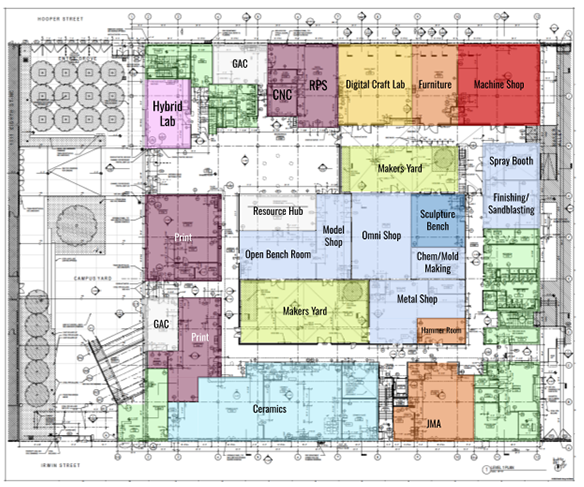
Ceramics Bench, Glaze, Kiln rooms

Digital Craft Lab
KUKA Robot, Potter bots

Digital Fabrication
CNC, RPS, Machine Shop
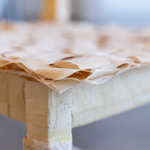
Furniture Bench, Machine Shop
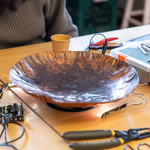
PCB Mill, Carvey Benchtop CNC, CircuitPython Bootloader

Jewelry / Metal Arts
JMA Bench, Chemical, Hammer rooms

Vandercook Press, Rutherford & Takach litho

Metal Shop room, JET Drill Press, MIG Welder
Upper Ground: 2nd fl Hooper Pavilion, 2nd fl Irwin Pavilion and gardens Copy link to {{value}} Copied to clipboard
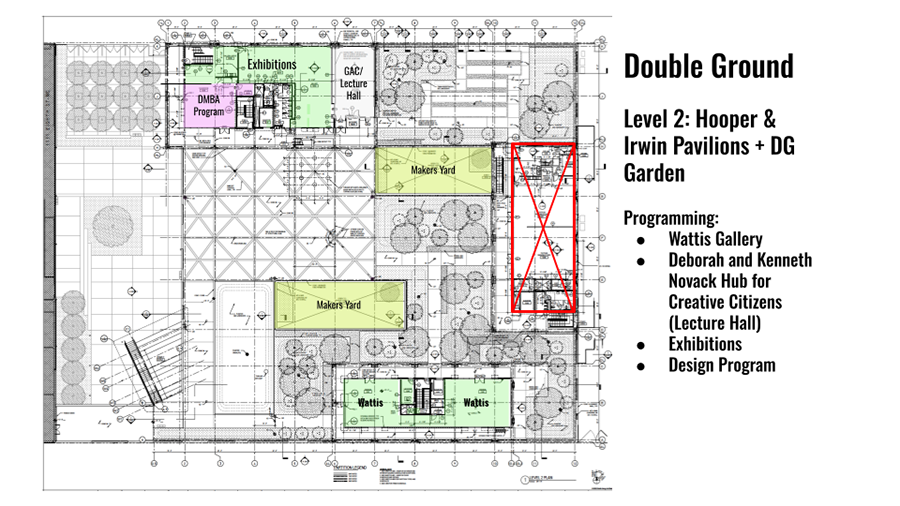
Hooper Pavilion, 2nd floor

DMBA Studios
Homeroom, Meeting rooms

CCA Exhibitions
2,000 sq. ft of new gallery space adjacent to lecture hall

Hub for Creative Citizens
60-person lecture hall
Irwin Pavilion & Gardens

Wattis Institute for Contemporary Arts

Cascade stairs connecting upper ground with entryway gardens

Upper Ground Gardens
Lawn, pathways, plantings

Dye & Fiber Garden
Hooper Pavilion 3rd + 4th floors Copy link to {{value}} Copied to clipboard
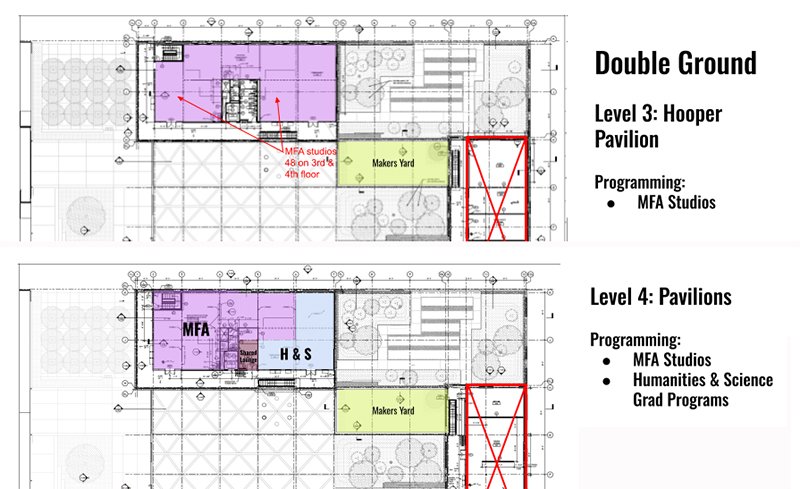
Timken MFA Fine Arts Studios
48 studios across 2 floors

Graduate Humanities & Sciences
MFA Comics, Writing, MA Visual + Critical Studies

Graduate student kitchen + lounge

IMAGES
VIDEO
COMMENTS
Marble: Conjures images of opulent palaces or Greek temples. Wood: Wooden lodges or cabins evoke feelings of nature, simplicity, and coziness. Glass: Mostly seen in modern office buildings or high-rises, suggesting transparency and sleek design. 3.
Building a Descriptive Vocabulary. The art of showing, not telling. Techniques for Describing Different Types of Buildings. Residential structures. Commercial and industrial buildings. Historic or landmark buildings. Describing Buildings in Different Settings. Painting a picture of idyllic countryside scenes.
44 Ways to Describe Buildings-Homes I. For the next few months, weekly writing tips will include word choice suggestions. That includes: colorful and original descriptions. pithy words and phrases. picture nouns and action verbs. writing that draws a reader in and addicts them to your voice. After taking some advice from Crawford Home Buyers ...
buildings. - quotes and descriptions to inspire creative writing. From golden stone to monochrome, the tall towers of the city stand in resolute togetherness all the year round. By Angela Abraham, @daisydescriptionari, December 30, 2020 . Centuries of grand design and sculpture came together in the wide avenues to form that eclectic yet ...
Set the scene early on - then nudge. It may sound obvious but plenty of writers launch out into a scene without giving us any descriptive material to place and anchor the action. Sure, a page or so into the scene, they may start to add details to it - but by that point it's too late. They've already lost the reader.
When posting images of buildings or other types of architecture online, I recommend including both alt text and image descriptions as it can be difficult to include thorough descriptions of a particular building or design with a limited amount of characters. Alt text is read out loud when hovering over the image, while image descriptions are ...
Complex: made of many interconnected parts. This complex building took several years to build because of its design. Damaged: harmed or broken. The storm left the building damaged beyond repair. Dark: not having enough light. It was a spooky and dark room. Dirty: covered in dirt.
Just description can be similar. You aren't painting a picture, you have a mind looking at a picture. Just the description can be under-imagined because you aren't imagining what these visions are doing to your character. Like talking, Viewing can be presented as an active experience influencing the mood, feelings, memories and plans of the viewer.
Get specific. Writing detailed descriptions is all about being careful with your language and choosing specific words and phrases that help to conjure up images for your reader. If you are vague or imprecise, it will be difficult for readers to do this. Take the opening of One Hundred Years of Solitude by Gabriel García Márquez, for example.
In this course aspiring writers will be introduced to the techniques that masters of fiction use to ground a story in a concrete world. From the most realist settings to the most fantastical, writers will learn how to describe the physical world in sharp, sensory detail. We will also learn how to build credibility through research, and to use ...
Worldbuilding: Create Brave New Worlds [+Template] Worldbuilding is the stage in the writing process where authors create believable settings for their stories. This may involve crafting a fictional world's history, geography, politics, and economy, as well as religions or powerstructures. Since creating a fictional universe is a daunting task ...
It is advice on how to break free of cliche approaches to painting, but it applies almost just as well to writing. The first step to vividly describing a place, person, or thing is to imagine it in your mind's eye. Alternately, if it actually exists you may prefer to look at it or a photograph directly. Either way, you'll start with some ...
Decaying House: Descriptive Writing Essay. The house, rather old and shabby, as Katherine would describe. The glass windows were broken and shattered across the floor board like an explosion. The floor board squeaked and cracked as a step is taken. Dust fell from the roof and danced like a ballerina in the air.
Writing description is a necessary skill for most writers. Whether we're writing an essay, a story, or a poem, we usually reach a point where we need to describe something. In fiction, we describe settings and characters. In poetry, we describe scenes, experiences, and emotions. In creative nonfiction, we describe reality.
4. Use the active voice. Concise, active words in your descriptive writing can make it more vivid. By starting with your subject, it infuses your sentences with action, creating activity and interest in your key message. Starting with the action can be exciting and invigorating to audiences, and keep them paying attention.
Writing effective descriptions. "Description begins in the writer's imagination, but should finish in the reader's.". - Stephen King. Descriptive writing is a powerful tool that adds life and depth to your writing. Effective descriptions breathe life into your ideas and put the reader in the scene where those ideas live.
Writing 101: Creating Effective Description. May 8, 2016 ~ Kaitlin Hillerich. The purpose of description is to help readers experience your story both with their senses and emotions. Contrary to popular belief, it's not there to look pretty or be flowery. Sure some writers can write very beautifully, but pretty prose isn't necessary to ...
A house that is no longer inhabited can make a mysterious setting in a novel across so many genres. If you need some words that describe an abandoned house, use the following 10 as a source of inspiration. 1. Deserted Definition. An area devoid of life; a wild or forbidding place.. Examples
In order to understand the purpose of description in creative writing, you have to understand why people love stories - why they read. People read to escape, for entertainment, and to learn. A major part of transporting your readers to the world of your story, bringing the events to life, and building compelling characters is by describing them.
Writing a composition about a city requires thorough research, observation, and a creative approach. Here is a step-by-step guide to help you write an engaging and descriptive composition about a city: Choose a city: Decide on the city you would like to write about. Make sure it is a city you are familiar with or have enough information about.
1. Give the characters wants and needs. First, it's important to point out that your main character will be inextricably linked to your book's plot.As author Tom Bromley teaches in his course on writing novels, "the protagonist should shape the plot, and the plot should shape the protagonist.". In this regard, the most important character building blocks are their Wants and Needs.
Adjectives like these are unnecessary and can bog down your writing. Simply cut those descriptive words out of the sentence. "The sky was dotted with clouds" conjures the exact same image and is shorter and more focused. 2. Use surprising words. Once your sentences are free of any obvious descriptive details, you have the space to pepper in ...
Description. As writer of prose, screenplays, comic scripts, or plays, all you have to entice your reader into your world is words. Black print, white page. That's it. What you do with those words will make the difference between a satisfied reader (or agent, or editor) begging for more, or your work being tossed in the "Not for me" pile.
Graduate student kitchen + lounge. California College of the Arts educates students to shape culture and society through the practice and critical study of art, architecture, design, and writing. Benefitting from its San Francisco Bay Area location, the college prepares students for lifelong creative work by cultivating innovation, community ...